Plants
Mt Takao is located at the borderline of warm-temperature zone and cool-temperature zone and various plants from both zones grow. There are a lot of naturally grown plants and their visitors can enjoy seasonal flowers. Over 1,500 kinds of plants are confirmed which is relevant to the number of kinds naturally grow in England. Also, over 60 kinds of plants are first found in Mt. Takao such as Takao Sumire (V. yezoensis f. discolor) and Takao Higotai (Saussurea sinuatoides).
-
Angelica decursiva Umbelliferae
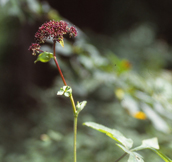
 Angelica decursiva Umbelliferae
Angelica decursiva Umbelliferae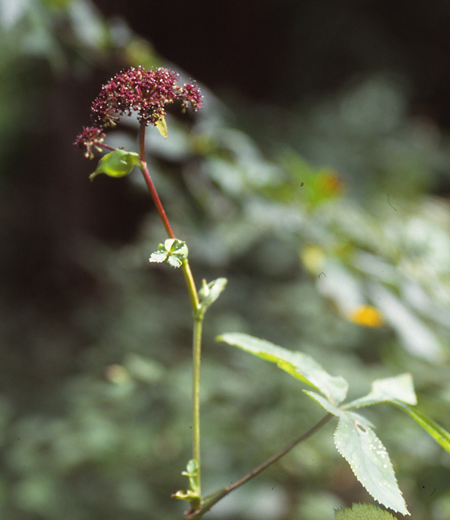 They are perennial plant that grows in the pool of forests, in the forests, and at grasslands in the mountain districts. (Perennial plant takes several years to grow). The upright-growing stalk is divided at the upper part into a few portions and is tinged with dark purplish. Though there are many white plants in the group of Umbelliferae, this plant is rarely tinged with dark purplish. More rarely, there are green ones or white ones. The flower is about 2 mm in diameter, on inflorescence (Kajo: stalk blooming flowers) grown from the top branch, sprout lots of flowers to be a cluster. As 5 flower petals face inward, they are seen as a flower bud even when they are blooming, and a male stamen projects outward from the inside. The leaf is compound leaf consisting of 3 leaves as one. Lobules are elliptically-shaped about 3 to 6 cm long (Shoyo: each one that is leaf-shaped and leaf like one consisting of more than a few leaves) is split deeply and has a rough sawtooth at the edge (sawtooth: Kyoshi, serrated edges like a saw-serrated edges at the tip of a leaf) with the back in whitish color. The characteristic is the portion at the leafstalk gets swollen to be saclike as a hull that holds the stalk. The seed is a cracked elliptically-shaped about 6 cm long and smells like curry.
They are perennial plant that grows in the pool of forests, in the forests, and at grasslands in the mountain districts. (Perennial plant takes several years to grow). The upright-growing stalk is divided at the upper part into a few portions and is tinged with dark purplish. Though there are many white plants in the group of Umbelliferae, this plant is rarely tinged with dark purplish. More rarely, there are green ones or white ones. The flower is about 2 mm in diameter, on inflorescence (Kajo: stalk blooming flowers) grown from the top branch, sprout lots of flowers to be a cluster. As 5 flower petals face inward, they are seen as a flower bud even when they are blooming, and a male stamen projects outward from the inside. The leaf is compound leaf consisting of 3 leaves as one. Lobules are elliptically-shaped about 3 to 6 cm long (Shoyo: each one that is leaf-shaped and leaf like one consisting of more than a few leaves) is split deeply and has a rough sawtooth at the edge (sawtooth: Kyoshi, serrated edges like a saw-serrated edges at the tip of a leaf) with the back in whitish color. The characteristic is the portion at the leafstalk gets swollen to be saclike as a hull that holds the stalk. The seed is a cracked elliptically-shaped about 6 cm long and smells like curry.
●Season Late August to about Early October
●Height about 80 cm to 1.5 m
●Place Trail 1, Trail 5, Ura-Takao, Oku-Takao -
Spuriopimpinella nikoensis Umbelliferae
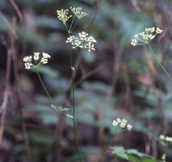
 Spuriopimpinella nikoensis Umbelliferae
Spuriopimpinella nikoensis Umbelliferae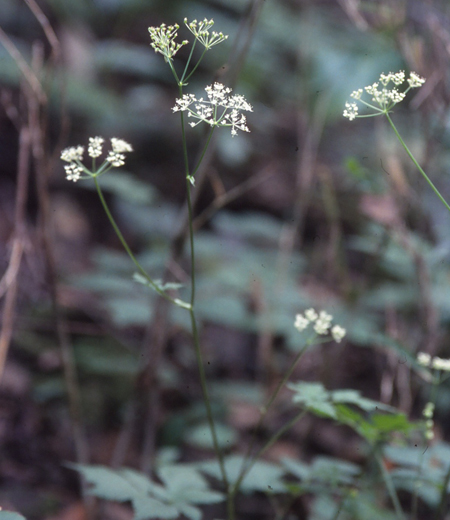 They are perennial plant that grows at such gloomy and humid places as in the pool of forests, in the forests in the mountain districts. (Perennial plant takes several years to grow). We seldom see them at Mt. Takao. The stalk is pillar-shaped and upright, and is divided at the upper part into. They grow in the shade and the shape of the leaf looks like the one of Cryptotaenia japonica, which is why they are named. The flower is white about 2 mm in diameter, on inflorescence (Kajo: stalk blooming flowers) grown from the top branch, sprout about 10 flowers to be a cluster. There are some such clusters. 5 flower petals face inward, and a male stamen projects long outward from the inside while a female stamen is split into 2 at the top. The leaf is twice ternate compound leaf consisting of 3 leaves as one on the 3-split branched top. The leaf has a long stalk and the leaves grow alternative on the stalk. Lobules are elliptically-shaped about 2 to 10 cm long (Shoyo: each one that is leaf-shaped and leaf like one consisting of more than a few leaves) and has a rough sawtooth at the edge (sawtooth: Kyoshi, serrated edges like a saw-serrated edges at the tip of a leaf). The characteristic of the leaf is thin and soft to touch.
They are perennial plant that grows at such gloomy and humid places as in the pool of forests, in the forests in the mountain districts. (Perennial plant takes several years to grow). We seldom see them at Mt. Takao. The stalk is pillar-shaped and upright, and is divided at the upper part into. They grow in the shade and the shape of the leaf looks like the one of Cryptotaenia japonica, which is why they are named. The flower is white about 2 mm in diameter, on inflorescence (Kajo: stalk blooming flowers) grown from the top branch, sprout about 10 flowers to be a cluster. There are some such clusters. 5 flower petals face inward, and a male stamen projects long outward from the inside while a female stamen is split into 2 at the top. The leaf is twice ternate compound leaf consisting of 3 leaves as one on the 3-split branched top. The leaf has a long stalk and the leaves grow alternative on the stalk. Lobules are elliptically-shaped about 2 to 10 cm long (Shoyo: each one that is leaf-shaped and leaf like one consisting of more than a few leaves) and has a rough sawtooth at the edge (sawtooth: Kyoshi, serrated edges like a saw-serrated edges at the tip of a leaf). The characteristic of the leaf is thin and soft to touch.
●Season Early September to about Early October
●Height about 30 to 80 cm
●Place Oku-Takao -
Dumasia truncate Leguminosae
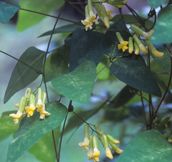
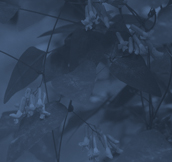 Dumasia truncate Leguminosae
Dumasia truncate Leguminosae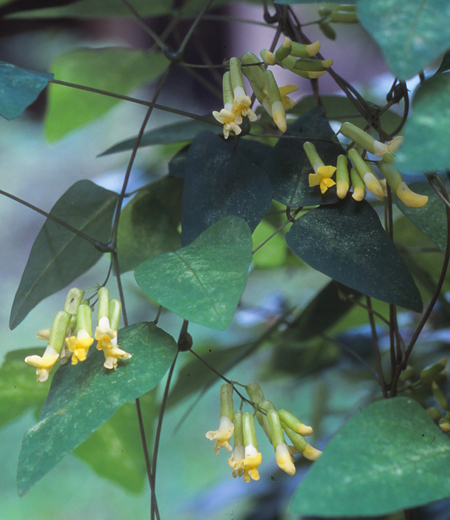 They are a perennial plant that grows in the pool of forests in the forests in the mountain districts. (Perennial plant takes several years to grow). They expand black-purple vine to the vegetation in that area to twine around it. They grow in the fields like Vigna unguiculata (Leguminosae) which is edible do. Therefore, they are named after this. The flower is about 1.5 to 2 cm long with the top being like a butterfly-shaped. On inflorescence (Kajo: stalk blooming flowers) grown from the side of the leaf, about 3 to 10 flowers to bloom downward. The calyx at the root of the flowers is a cylindrical shape in pale lime green color with sepal split shallow. The leaf consists of 3 leaves as one and grows alternative on the stalk. Lobules are long egged-shaped about 3 to 15 cm long (Shoyo: each one that is leaf-shaped and leaf like one consisting of more than a few leaves). The characteristic of the leaf is thin and sparse paraphyllium grows with the back white-fleshed. When the flowers wither, they bear the hull-shaped seeds. When matured, the seeds are split out spherical seedling dangling, about 5 mm in diameter.
They are a perennial plant that grows in the pool of forests in the forests in the mountain districts. (Perennial plant takes several years to grow). They expand black-purple vine to the vegetation in that area to twine around it. They grow in the fields like Vigna unguiculata (Leguminosae) which is edible do. Therefore, they are named after this. The flower is about 1.5 to 2 cm long with the top being like a butterfly-shaped. On inflorescence (Kajo: stalk blooming flowers) grown from the side of the leaf, about 3 to 10 flowers to bloom downward. The calyx at the root of the flowers is a cylindrical shape in pale lime green color with sepal split shallow. The leaf consists of 3 leaves as one and grows alternative on the stalk. Lobules are long egged-shaped about 3 to 15 cm long (Shoyo: each one that is leaf-shaped and leaf like one consisting of more than a few leaves). The characteristic of the leaf is thin and sparse paraphyllium grows with the back white-fleshed. When the flowers wither, they bear the hull-shaped seeds. When matured, the seeds are split out spherical seedling dangling, about 5 mm in diameter.
●Season Early September to about Mid September
●Height – climbing plant
●Place Trail 1 to 2, Trail 4 to 5, Oku-Takao -
Vicia unijuga Leguminosae
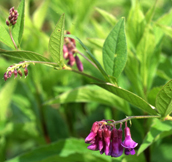
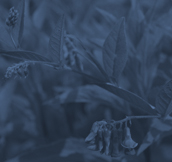 Vicia unijuga Leguminosae
Vicia unijuga Leguminosae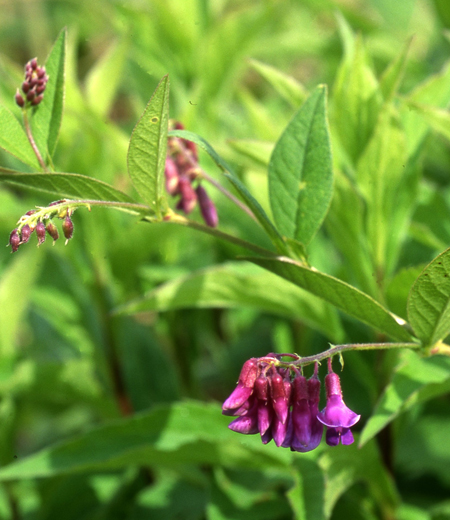 Perennial herbs (grow for several years from their same root system) found in sunny forest edges and riverbanks. Upright stems have fin-like ribs. Flowers are 1..5 cm long and tips are pointed like butterflies. Color of flowers is red-purple and bloom on 2 to 4 cm inflorescence. Leaves are two-leaves compound leaves and alternate. Each leaf is 3 to 7 cm long, long egg-shaped, hairy and with short petioles. The Japanese name Nanten-hagi was named because the shape of leaves resembles nandina domestica (nanten in Japanese and hagi is bush clover). This is also called Futaba-hagi literally meaning two leaves bush clover named after the two compounded leaves. After flowering, bear 3 cm long loment like peas with three to seven seeds. Sprout in spring is called Azukina and can be eaten as wild vegetable.
Perennial herbs (grow for several years from their same root system) found in sunny forest edges and riverbanks. Upright stems have fin-like ribs. Flowers are 1..5 cm long and tips are pointed like butterflies. Color of flowers is red-purple and bloom on 2 to 4 cm inflorescence. Leaves are two-leaves compound leaves and alternate. Each leaf is 3 to 7 cm long, long egg-shaped, hairy and with short petioles. The Japanese name Nanten-hagi was named because the shape of leaves resembles nandina domestica (nanten in Japanese and hagi is bush clover). This is also called Futaba-hagi literally meaning two leaves bush clover named after the two compounded leaves. After flowering, bear 3 cm long loment like peas with three to seven seeds. Sprout in spring is called Azukina and can be eaten as wild vegetable.
●Season June to about October
●Height about 30 to 60 cm
●Place Ura-Takao -
Amphicarpaea edgeworthii var. japonica Leguminosae
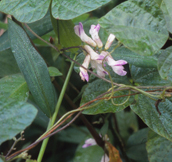
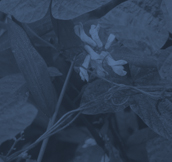 Amphicarpaea edgeworthii var. japonica Leguminosae
Amphicarpaea edgeworthii var. japonica Leguminosae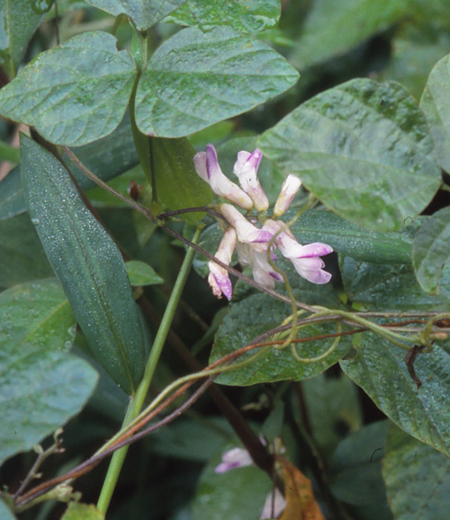 They are an annual plant that grows in the pool of the forests and at the grasslands in sunny mountain district. The stalk grows thickly downward paraphyllium and is thin and long to expand about 1 m to tangle in the other vegetation. We see them mostly in thicket, and then this is why they are named. The flower is about 2 cm long with the top being like a butterfly-shaped. The whitish edge of the flower petal is dark purple color and some are on inflorescence (Kajo: stalk blooming flowers) grown from the side of the leaf. Another characteristic is that except this flower, they have cleistogamous flower (Heisaka: the flower which does not blossom but pollinates itself) both on the ground and at the underground stem. The leaf consists of 3 as one and grows alternative. Lobules are wide egged-shaped about 3 to 6 cm long (Shoyo: each one that is leaf-shaped and leaf like one consisting of more than a few leaves) has paraphyllium to grow. When the flowers wither, they bear the hull-shaped seeds. When matured, the seeds are split half out to produce quail-egged shaped seedlings with black patterns.
They are an annual plant that grows in the pool of the forests and at the grasslands in sunny mountain district. The stalk grows thickly downward paraphyllium and is thin and long to expand about 1 m to tangle in the other vegetation. We see them mostly in thicket, and then this is why they are named. The flower is about 2 cm long with the top being like a butterfly-shaped. The whitish edge of the flower petal is dark purple color and some are on inflorescence (Kajo: stalk blooming flowers) grown from the side of the leaf. Another characteristic is that except this flower, they have cleistogamous flower (Heisaka: the flower which does not blossom but pollinates itself) both on the ground and at the underground stem. The leaf consists of 3 as one and grows alternative. Lobules are wide egged-shaped about 3 to 6 cm long (Shoyo: each one that is leaf-shaped and leaf like one consisting of more than a few leaves) has paraphyllium to grow. When the flowers wither, they bear the hull-shaped seeds. When matured, the seeds are split half out to produce quail-egged shaped seedlings with black patterns.
●Season September to about October
●Height – climbing plant
●Place Trail 1, Trail 4 to 6, Ura-Takao -
Clematis stans Ranunculaceae
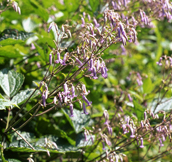
 Clematis stans Ranunculaceae
Clematis stans Ranunculaceae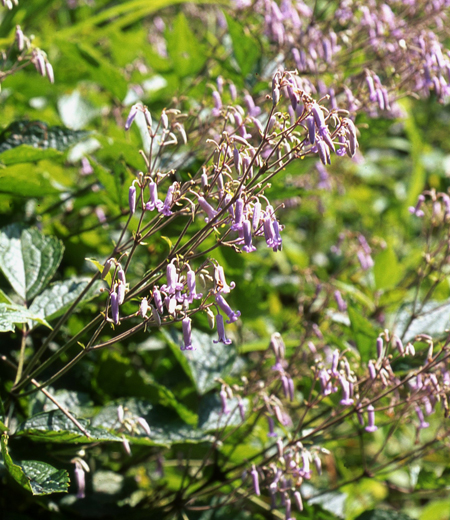 They are perennial plant that grows at the pool of mountain district and grasslands. (Perennial plant takes several years to grow). The stalk at the bottom part becomes composition which remains still there till winter. The leaf looks like the shape of the one of Paeonia suffruticosa. This is why they are named ‘Clematis stans’. Many flowers bloom downward aside of the leaves or at the top of stalk. The flower is bell-shaped about 1 to 2 cm long with no flower petals, and blooms with 4 sepals rolling-back. The flower is pale purplish-tingled color and bears paraphyllium outside of the calyx. They have a stamen a male flower and a female flower, and each of them blossom in separate trees. The longer tube is a male flower and the shorter one is a female flower. The leaf consists three as one named ‘trifoliate compound leaf’, with a long stalk growing alternative to stem. Lobules (Shoyo: each one that is leaf-shaped and leaf like one consisting of more than a few leaves) is egged-shaped about 5 to 10 cm long, has a sharp tip with the edge shallow and divided into 3. After flowers wither, they bear the seeds about 3 to 3.5 cm long at the top which flower style grows long.
They are perennial plant that grows at the pool of mountain district and grasslands. (Perennial plant takes several years to grow). The stalk at the bottom part becomes composition which remains still there till winter. The leaf looks like the shape of the one of Paeonia suffruticosa. This is why they are named ‘Clematis stans’. Many flowers bloom downward aside of the leaves or at the top of stalk. The flower is bell-shaped about 1 to 2 cm long with no flower petals, and blooms with 4 sepals rolling-back. The flower is pale purplish-tingled color and bears paraphyllium outside of the calyx. They have a stamen a male flower and a female flower, and each of them blossom in separate trees. The longer tube is a male flower and the shorter one is a female flower. The leaf consists three as one named ‘trifoliate compound leaf’, with a long stalk growing alternative to stem. Lobules (Shoyo: each one that is leaf-shaped and leaf like one consisting of more than a few leaves) is egged-shaped about 5 to 10 cm long, has a sharp tip with the edge shallow and divided into 3. After flowers wither, they bear the seeds about 3 to 3.5 cm long at the top which flower style grows long.
●Season September to about October
●Height about 50cm to 1 m
●Place Mt.Inari, Ura-Takao,Oku-Takao -
Cimicifuga simplex Ranunculaceae
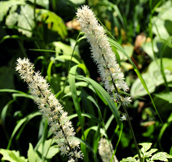
 Cimicifuga simplex Ranunculaceae
Cimicifuga simplex Ranunculaceae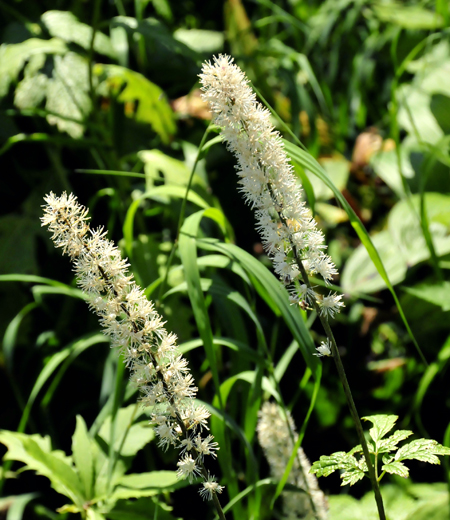 They are perennial plant that grows under the trees of mountain district and along the mountain stream. (Perennial plant takes several years to grow). They bear spikes (Kasui: small flowers gathering to be like head of plant) brush-shaped about 10 to 30 cm at the grown-high stalk. The spikes hold more than 150 flowers about 5 to 7 cm long. Though they resemble Cimicifuga japonica in the same group, the good difference to distinguish is that Cimicifuga simplex’s leaves differ from the ones of Cimicifuga japonica, and Cimicifuga simplex’s flowers have a stalk about 1 cm long. The leaf consists three as one named compound leaf, with a long stalk growing alternative to stem. Lobules (Shoyo: each one that is leaf-shaped and leaf like one consisting of more than a few leaves) is egged-shaped about 3 to 8 cm long, has a sharp tip and with spiny sawtooth at the edge (Kyoshi: tooth-like rough part like a saw at the root of a leaf). How they are named is people boiled the fresh leaves and immersed them in ice water to eat, and then they are called ‘Cimicifuga simplex’ (Sarashina-shoma). Shoma is a Chinese name. After flowers wither, they bear the seeds about 1 cm long. When matured, the seeds get split up and produce the seeds with shallow wrinkles.
They are perennial plant that grows under the trees of mountain district and along the mountain stream. (Perennial plant takes several years to grow). They bear spikes (Kasui: small flowers gathering to be like head of plant) brush-shaped about 10 to 30 cm at the grown-high stalk. The spikes hold more than 150 flowers about 5 to 7 cm long. Though they resemble Cimicifuga japonica in the same group, the good difference to distinguish is that Cimicifuga simplex’s leaves differ from the ones of Cimicifuga japonica, and Cimicifuga simplex’s flowers have a stalk about 1 cm long. The leaf consists three as one named compound leaf, with a long stalk growing alternative to stem. Lobules (Shoyo: each one that is leaf-shaped and leaf like one consisting of more than a few leaves) is egged-shaped about 3 to 8 cm long, has a sharp tip and with spiny sawtooth at the edge (Kyoshi: tooth-like rough part like a saw at the root of a leaf). How they are named is people boiled the fresh leaves and immersed them in ice water to eat, and then they are called ‘Cimicifuga simplex’ (Sarashina-shoma). Shoma is a Chinese name. After flowers wither, they bear the seeds about 1 cm long. When matured, the seeds get split up and produce the seeds with shallow wrinkles.
●Season Late September to about Late October
●Height about 60cm to 1.2 m
●Place Trail 1, Trail 4 to 6, Mt.Inari, Ura-Takao, Oku-Takao -
Aconitum japonicum ssp. japonicum Ranunculaceae
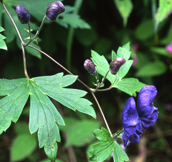
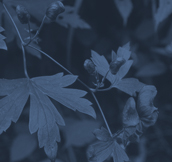 Aconitum japonicum ssp. japonicum Ranunculaceae
Aconitum japonicum ssp. japonicum Ranunculaceae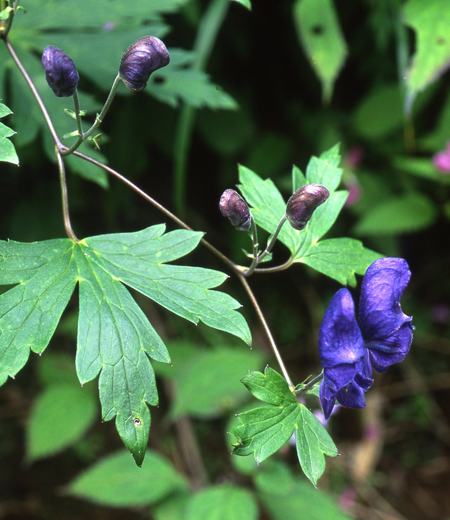 They are perennial plant that grows at the forests along the mountain stream and at the pool of forests. (Perennial plant takes several years to grow). They are well-known as a poisonous plant, all the portions of this grass contain deadly poison named aconitine, and eating by mistake brings about cramp and respiratory distress to lead those who to death. The stalk is upright at the plain field, but bends backward in the forest. The shape of the flower looks like ‘Torikabuto’ which means a Chinese phoenix’s head shaped crown that ancient dancer wears for court dance and music. This is why they are named. The flower is vivid bluish-purple about 3 cm long. What looks like flowers consists of 5 sepals with a real petal inside of it. The leaf is about 6 to 20 cm long and grows alternative on the stalk. The leaves have 3 to 5 lacinia split into half, have a rough sawtooth at the edge (Kyoshi: tooth-like rough part like a saw at the root of a leaf). After flowers wither, they bear 3 to 5 seeds. When matured, the seeds get split up and produce the seeds with shallow wrinkles.
They are perennial plant that grows at the forests along the mountain stream and at the pool of forests. (Perennial plant takes several years to grow). They are well-known as a poisonous plant, all the portions of this grass contain deadly poison named aconitine, and eating by mistake brings about cramp and respiratory distress to lead those who to death. The stalk is upright at the plain field, but bends backward in the forest. The shape of the flower looks like ‘Torikabuto’ which means a Chinese phoenix’s head shaped crown that ancient dancer wears for court dance and music. This is why they are named. The flower is vivid bluish-purple about 3 cm long. What looks like flowers consists of 5 sepals with a real petal inside of it. The leaf is about 6 to 20 cm long and grows alternative on the stalk. The leaves have 3 to 5 lacinia split into half, have a rough sawtooth at the edge (Kyoshi: tooth-like rough part like a saw at the root of a leaf). After flowers wither, they bear 3 to 5 seeds. When matured, the seeds get split up and produce the seeds with shallow wrinkles.
●Season Late September to about Late October
●Height about 40cm to 1m
●Place Ura-Takao -
Asarum nipponicum Aristolochiaceae
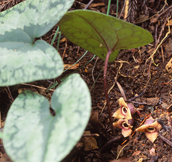
 Asarum nipponicum Aristolochiaceae
Asarum nipponicum Aristolochiaceae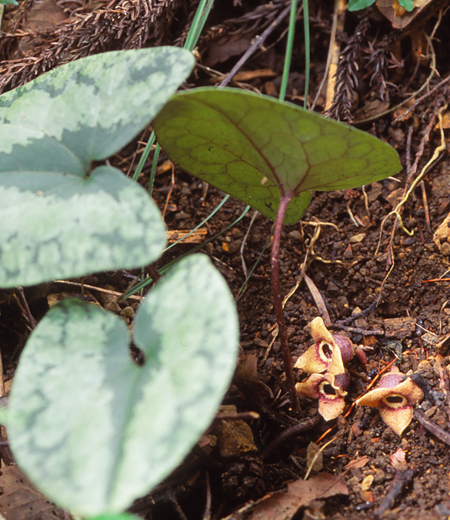 They are a perennial evergreen plant that ordinarily grows at the woodland paths in the countryside (Perennial plant takes several years to grow). They bear green leaves even in the winter, which is the reason for their name. Also, as they can be seen mainly in the mountain district in Kanto region, they have another name ‘kooyana var. nipponica’ (Kantou-Kan-aoi). The leaf is a wide egged-shaped about 6 to 10 cm long, have a long stalk, which has white patterns along the leaf veins on the surface. The flower is about 2 cm long in diameter. The flower consists of 3 roundish triangular sepals about 1 cm long as if they are the flower petals. The flower is tinged with dark purple like withered leaves, only 1 grows at the leafstalk at the closest position from the ground, and then produces the seeds out when matured and collapsed. The seeds have strophiole (Synching: soft substance attaching to the seeds), which is ants’ feed, thus, the ants carry the seeds away.
They are a perennial evergreen plant that ordinarily grows at the woodland paths in the countryside (Perennial plant takes several years to grow). They bear green leaves even in the winter, which is the reason for their name. Also, as they can be seen mainly in the mountain district in Kanto region, they have another name ‘kooyana var. nipponica’ (Kantou-Kan-aoi). The leaf is a wide egged-shaped about 6 to 10 cm long, have a long stalk, which has white patterns along the leaf veins on the surface. The flower is about 2 cm long in diameter. The flower consists of 3 roundish triangular sepals about 1 cm long as if they are the flower petals. The flower is tinged with dark purple like withered leaves, only 1 grows at the leafstalk at the closest position from the ground, and then produces the seeds out when matured and collapsed. The seeds have strophiole (Synching: soft substance attaching to the seeds), which is ants’ feed, thus, the ants carry the seeds away.
●Season October to about April
●Height about 10 cm
●Place Trail 1, Trail 4, Mt.Inari, Ura-Takao, Minami-Takao -
Amaryllidaceae Amaryllidaceae
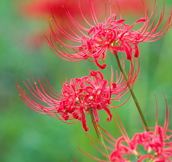
 Amaryllidaceae Amaryllidaceae
Amaryllidaceae Amaryllidaceae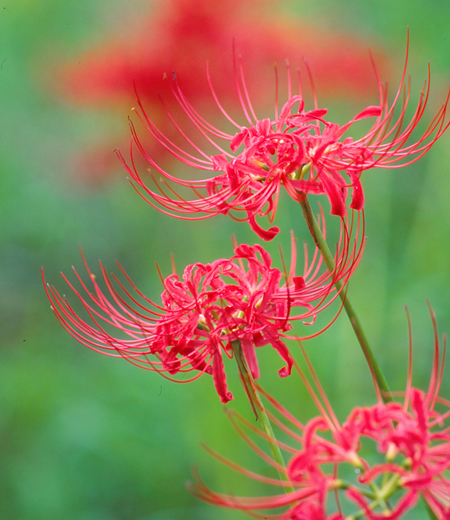 They are perennial plant that grows in clusters in the river bank, footpath between rice fields, and graveyards (Perennial plant takes several years to grow). It is thought that they were imported from ancient China. The reason for their name is that around the time of autumn during equinoctial week, they bear bright red flowers. They also have another name ‘Lycoris radiata’ which means the unworldly red flower in the Lotus Sutra. At the top of the upright-growing flower stalk (Kakei: stem of flower bearing only flowers without leaves) sprouting from the bulb (Rinkei: a modified leaf by nutrient accumulation being attached firmly to short stalk), 5 to 7 flowers bloom in a cluster. The flower has 6 thin flower petals about 4 centimeters long rolled back and a male stamen projects long. No leaves sprout during blooming, grow in latest autumn, pass the winter through, and wither in the next spring. The leaf is thin and long about 30 to 60 cm long, 6 to 8 mm wide. The leaves are dark shiny green color with the center in whitish color along the leaf vein. Entire portions of this plant contain poisonous elements, especially much in discoid stem (bulb). When eaten by mistake, this poison brings about the symptoms such as vomiting and diarrhea, in some cases, may lead to death.
They are perennial plant that grows in clusters in the river bank, footpath between rice fields, and graveyards (Perennial plant takes several years to grow). It is thought that they were imported from ancient China. The reason for their name is that around the time of autumn during equinoctial week, they bear bright red flowers. They also have another name ‘Lycoris radiata’ which means the unworldly red flower in the Lotus Sutra. At the top of the upright-growing flower stalk (Kakei: stem of flower bearing only flowers without leaves) sprouting from the bulb (Rinkei: a modified leaf by nutrient accumulation being attached firmly to short stalk), 5 to 7 flowers bloom in a cluster. The flower has 6 thin flower petals about 4 centimeters long rolled back and a male stamen projects long. No leaves sprout during blooming, grow in latest autumn, pass the winter through, and wither in the next spring. The leaf is thin and long about 30 to 60 cm long, 6 to 8 mm wide. The leaves are dark shiny green color with the center in whitish color along the leaf vein. Entire portions of this plant contain poisonous elements, especially much in discoid stem (bulb). When eaten by mistake, this poison brings about the symptoms such as vomiting and diarrhea, in some cases, may lead to death.
●Season Mid September to about Late September
●Height about 30 to 50 cm
●Place Ura-Takao,Oku-Takao -
Oplismenus undulatifolius Poaceae
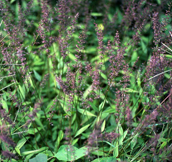
 Oplismenus undulatifolius Poaceae
Oplismenus undulatifolius Poaceae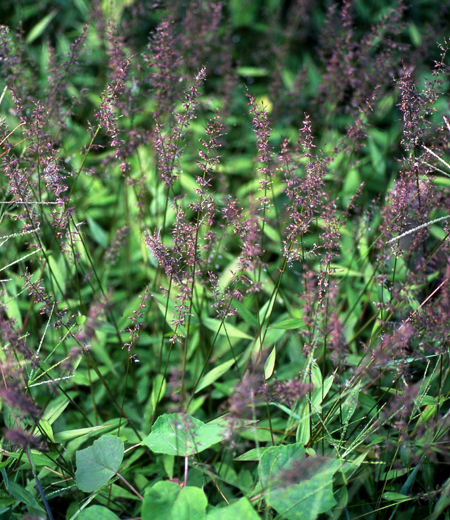 They are a perennial plant that ordinarily grows at the woodland paths and the roadside in the countryside (Perennial plant takes several years to grow). The thin stalk gets split over and over again to expand creeping on the ground, and the top upstands. The leaf is thin and long elliptically-shaped, about 3 to 7 cm long, about 1 to 1.5 cm wide with the sharp top and also the root portion attaching like holding the stalk. The reason for their name is that the shape of the leaf looks like bamboo grass and that the leaves get wrinkled at the edge as if they crispate. This is why they are named ‘Oplismenus undulatifoliu’ (Chizimizasa). They grow Scape (Kakei: the stem with only flowers and no leaves) about 10 to 15 cm from the top of the stem, and then develop 6 to 10 of short branches with some white dense spikelet (Shosui: a part of plant) in cluster. Spikelet is thin egged-shaped about 3 mm long, has an acerate protruding object called ‘awn’ (Nogi), which is typical among the group of Gramineae. When the matured seeds are easy to get off from spikelet (Shosui), and they excrete a sticky liquid from awn (Nogi), so that they can be attached to animals and human being on the clothes to be carried.
They are a perennial plant that ordinarily grows at the woodland paths and the roadside in the countryside (Perennial plant takes several years to grow). The thin stalk gets split over and over again to expand creeping on the ground, and the top upstands. The leaf is thin and long elliptically-shaped, about 3 to 7 cm long, about 1 to 1.5 cm wide with the sharp top and also the root portion attaching like holding the stalk. The reason for their name is that the shape of the leaf looks like bamboo grass and that the leaves get wrinkled at the edge as if they crispate. This is why they are named ‘Oplismenus undulatifoliu’ (Chizimizasa). They grow Scape (Kakei: the stem with only flowers and no leaves) about 10 to 15 cm from the top of the stem, and then develop 6 to 10 of short branches with some white dense spikelet (Shosui: a part of plant) in cluster. Spikelet is thin egged-shaped about 3 mm long, has an acerate protruding object called ‘awn’ (Nogi), which is typical among the group of Gramineae. When the matured seeds are easy to get off from spikelet (Shosui), and they excrete a sticky liquid from awn (Nogi), so that they can be attached to animals and human being on the clothes to be carried.
●Season Mid September to about Late October
●Height about 10 to 30 cm
●Place Ura-Takao -
Torreya nucifera Taxaceae
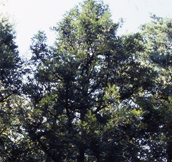
 Torreya nucifera Taxaceae
Torreya nucifera Taxaceae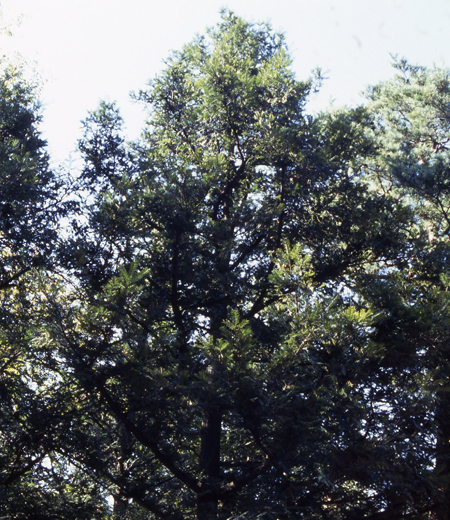 They are ever green arboreal that grows in mountains. Cortex of seedling is pale grey and smooth feeling to touch but when matured, they are divided to be peeled off likely oblong in line. The trunks are about 2 m wide, their lumbers are superior in close and having durability, and so they are widely used for construction materials. Their leaves are about 2 to 3 cm long, about 2 to 3 cm wide and long. They are very tough and luster with the top of them is sharp. When we touch them, it is painful for us unlike Dog Torreya. Their blossom seasons are about April to May, and a dioecious plant (Shiyuuisyu). They have a male flower beside the leaf of the branch that grew the previous year, and a female flower at the top of the branch.Their fruits are elliptically-shaped about 2 to 4 cm long, an aril (Kahisyu) like lichen covers seeds, and next October they are matured. Their seeds are very spicy and delicious when removed of astringent taste and roasted.
They are ever green arboreal that grows in mountains. Cortex of seedling is pale grey and smooth feeling to touch but when matured, they are divided to be peeled off likely oblong in line. The trunks are about 2 m wide, their lumbers are superior in close and having durability, and so they are widely used for construction materials. Their leaves are about 2 to 3 cm long, about 2 to 3 cm wide and long. They are very tough and luster with the top of them is sharp. When we touch them, it is painful for us unlike Dog Torreya. Their blossom seasons are about April to May, and a dioecious plant (Shiyuuisyu). They have a male flower beside the leaf of the branch that grew the previous year, and a female flower at the top of the branch.Their fruits are elliptically-shaped about 2 to 4 cm long, an aril (Kahisyu) like lichen covers seeds, and next October they are matured. Their seeds are very spicy and delicious when removed of astringent taste and roasted.
●Height about 20 to 30 m
●Place Trail 3 and 4, Ura-Takao -
Chephalotaxus harringtonia Cephalotaxaceae
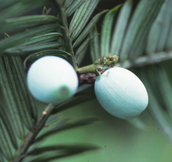
 Chephalotaxus harringtonia Cephalotaxaceae
Chephalotaxus harringtonia Cephalotaxaceae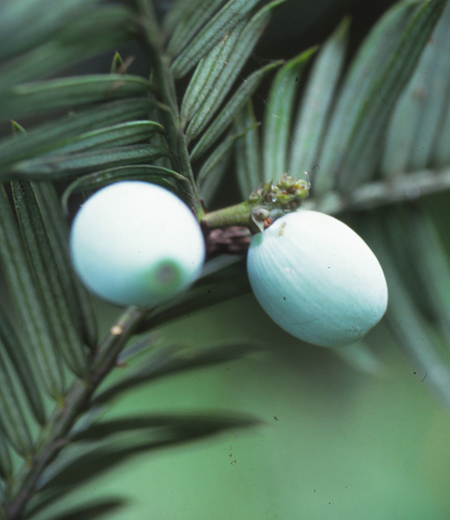 They are small ever green arboreal tree growing small thin and long flat leaves. Cortex is dark brown, and vertically split to be cracked off. Their leaves grow in line on both sides of the branches, about 2 to 5 cm long, very short on surface, and not painful to touch. Their blossom seasons are about March to April, and a dioecious plant (Shiyuuisyu). They grow a male flower at the root of the leaf of the branch that grew the previous year, and a female flower at the top of the leaf. Next autumn, the seeds get matured to turn into red-purple color. In case that a part of the plant’s Japanese name is dog, it usually means it’s of no use. This small arboreal plants are similar to Torreya nucifera, they are inferior to Torreya nucifera. Although Torreya nucifera grow up to be large trees and they are used for construction materials, this plant is not proper for it. The nuts of Torreya nucifera are good taste but the nuts of this tree are so bitter that they are not edible.
They are small ever green arboreal tree growing small thin and long flat leaves. Cortex is dark brown, and vertically split to be cracked off. Their leaves grow in line on both sides of the branches, about 2 to 5 cm long, very short on surface, and not painful to touch. Their blossom seasons are about March to April, and a dioecious plant (Shiyuuisyu). They grow a male flower at the root of the leaf of the branch that grew the previous year, and a female flower at the top of the leaf. Next autumn, the seeds get matured to turn into red-purple color. In case that a part of the plant’s Japanese name is dog, it usually means it’s of no use. This small arboreal plants are similar to Torreya nucifera, they are inferior to Torreya nucifera. Although Torreya nucifera grow up to be large trees and they are used for construction materials, this plant is not proper for it. The nuts of Torreya nucifera are good taste but the nuts of this tree are so bitter that they are not edible.
●Height about 6 to 10 m
●Place Trail 4, Minami-Takao, Kita-Takao -
Pinus densiflora Pinaceae
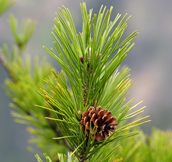
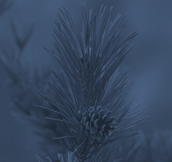 Pinus densiflora Pinaceae
Pinus densiflora Pinaceae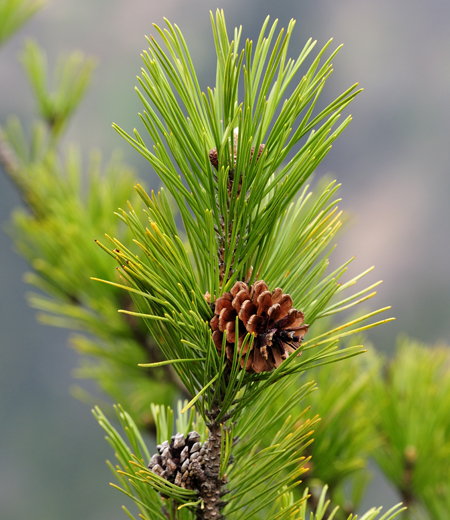 They are a deciduous tall tree that bears needle-like leaves. The trunk grows to be about 1.2 m wide, and is often planted for garden trees and windbreak forests. Cortex is tinged with red, therefore, they are named ‘Pinus densiflora’ (Akamatsu). Though they look like Pinus thunbergii Parlatore (Kuromatsu) in the same group of Pinaceae, the leaves of Akamatsu are rather thin and soft. This fact results in calling Kuromatsu by ‘male pine tree’ and Akamatsu by ‘female pine tree’. They survive to grow even at arid and poor soil to grow wild along the ridge of a plateau located around 2,000 m above sea level. Decades ago, we used to see Akamatsu even at Mt. Takao, but nowadays we seldom see them. The blossom seasons are about April to May and hermaphroditism plant (Shiyuudousyu). Yellow male flowers sprout on a new branch, while 2 to 3 of purple-red female flowers sprout at the limb of the branch. The seeds are egged-shaped and get matured next autumn to be woodsy pinecone (Matsu-bokkuri).
They are a deciduous tall tree that bears needle-like leaves. The trunk grows to be about 1.2 m wide, and is often planted for garden trees and windbreak forests. Cortex is tinged with red, therefore, they are named ‘Pinus densiflora’ (Akamatsu). Though they look like Pinus thunbergii Parlatore (Kuromatsu) in the same group of Pinaceae, the leaves of Akamatsu are rather thin and soft. This fact results in calling Kuromatsu by ‘male pine tree’ and Akamatsu by ‘female pine tree’. They survive to grow even at arid and poor soil to grow wild along the ridge of a plateau located around 2,000 m above sea level. Decades ago, we used to see Akamatsu even at Mt. Takao, but nowadays we seldom see them. The blossom seasons are about April to May and hermaphroditism plant (Shiyuudousyu). Yellow male flowers sprout on a new branch, while 2 to 3 of purple-red female flowers sprout at the limb of the branch. The seeds are egged-shaped and get matured next autumn to be woodsy pinecone (Matsu-bokkuri).
●Height about 25 to 40 m
●Place Near streamside -
Abies firma Pinaceae
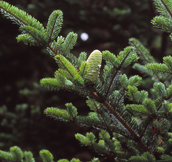
 Abies firma Pinaceae
Abies firma Pinaceae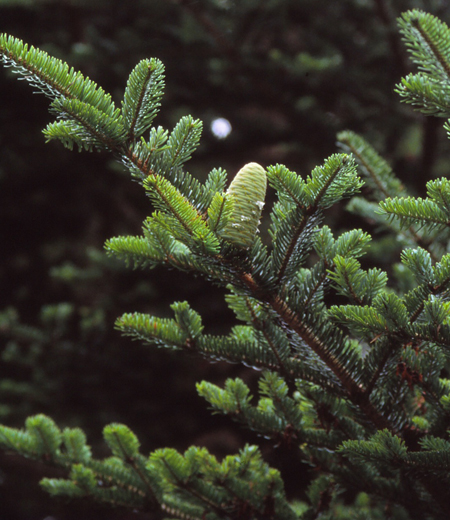 They are a deciduous tall tree that grows wild around hilly district to the mountain areas. Cortex is ash gray color and the one of young trees is smooth feeling to touch, but once grown adult trees the cortex is split scaly. Their characteristic is they grow very rapidly, and are like to go rotten. The trunk grows to be about 1 m wide. They are planted as garden trees, and the wood is utilized for material for building construction as well as the materials to make coffins and a tall, narrow wooden tablet (Sotoba: material of Buddhism, set up behind a grave for the pray for the dead). The leaves are about 2 to 3.5 cm long and thin and long with a flat cross-sectional surface. Usually they have a little dent at the limb, but the leaves of young trees are split into 2. The blossom season is around May and hermaphroditism plant (Shiyuudousyu). Yellow male flowers consist of many male stamens gathering cylindrically on the branch that extended the previous year, while green female flowers sprout beside the leaf of the same tree. The seeds are a circular cylindrical shape alike woodsy pinecone (Matsu-bokkuri), about 10 to 15 cm long. They get matured in October, the year of blossoms, and then fall discretely.
They are a deciduous tall tree that grows wild around hilly district to the mountain areas. Cortex is ash gray color and the one of young trees is smooth feeling to touch, but once grown adult trees the cortex is split scaly. Their characteristic is they grow very rapidly, and are like to go rotten. The trunk grows to be about 1 m wide. They are planted as garden trees, and the wood is utilized for material for building construction as well as the materials to make coffins and a tall, narrow wooden tablet (Sotoba: material of Buddhism, set up behind a grave for the pray for the dead). The leaves are about 2 to 3.5 cm long and thin and long with a flat cross-sectional surface. Usually they have a little dent at the limb, but the leaves of young trees are split into 2. The blossom season is around May and hermaphroditism plant (Shiyuudousyu). Yellow male flowers consist of many male stamens gathering cylindrically on the branch that extended the previous year, while green female flowers sprout beside the leaf of the same tree. The seeds are a circular cylindrical shape alike woodsy pinecone (Matsu-bokkuri), about 10 to 15 cm long. They get matured in October, the year of blossoms, and then fall discretely.
●Height about 25 to 40 m
●Place Trail 3 and 4,Iroha -
Cryptomeria japonica(Japanese Cedar) Taxodiaceae
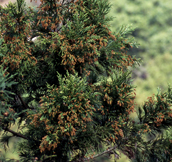
 Cryptomeria japonica(Japanese Cedar) Taxodiaceae
Cryptomeria japonica(Japanese Cedar) Taxodiaceae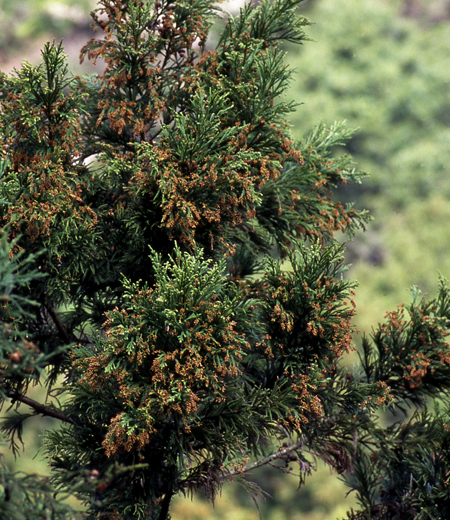 Taxodiaceae
Taxodiaceae
They are an evergreen tree that grows wild along the mountain streams in the mountain areas. As they are utilized as material for building construction, we can see them here and there in Mt. Takao, too. Along Trail 5, ‘EGAWA-Japanese cedar’ is known to people, which was planted by Mr. Tarozaemon EGAWA during Edo era, who was an Edo-period prefectural governor. Cortex is tinged with reddish brown and vertically split as well as slightly peeled off in strips. The trunk grows to be about 1 to 2 m wide. The leaves are a little bit looping acerate about 1 cm long with the sharp top growing in a spiral manner on the branch. The blossom seasons are about March to April and a monoecious plant. Pale yellow male flowers sprout gather like scions on the branch which extended the previous year, while 1 green color female flower sprouts. The seeds are a spherical shape about 2 to 3 cm in diameter with about 30 of brown wooded scale-likes attached.
●Height about 30 to 40 m
●Place Trail 1 to 6, Mt.Inari, Jyataki, Iroha, Ura-Takao, Oku-Takao, Minami- Takao, Kita-Takao -
Chamaecyparis obtura Cupressaceae
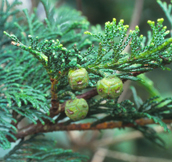
 Chamaecyparis obtura Cupressaceae
Chamaecyparis obtura Cupressaceae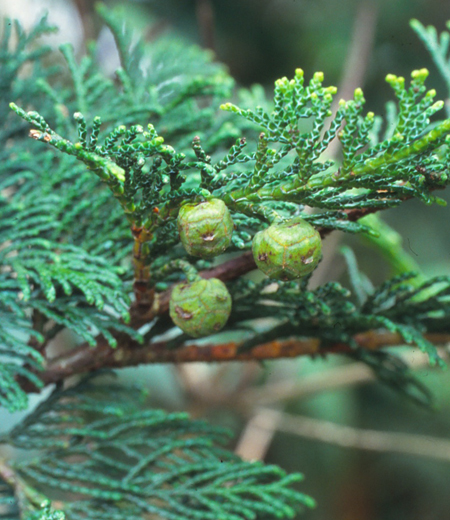 They are an evergreen tree that grows wild at such arid places as at mountainsides and mountain ridges in the mountain areas. As it is the same case with Japanese cedar, they have been planted all over around Japan to be utilized for building materials resources. Cortex is red-brown and widely vertically split to be peeled off. The trunk grows to be about 60 cm wide, while the branch expands thin horizontally. The dense leaves grow gather in a shape of small scale with the common top. They have stomata line (a line of small holes which let the air in and out, and moisture blow off), which is at the back and looks like Y-letter feature. The blossom season is about April and hermaphroditism plant (Shiyuudousyu), which has purplish brown male flowers and female flowers on the limb of the branch. A male flower is elliptically-shaped about 2 to 3 mm long, tinged with red, while female flower is a spherical shape about 3 to 5 mm in diameter. The seeds are a spherical shape about 1 cm in diameter with about 8 to 10 of wooded scale-likes attached. The seeds get matured to red-brown in October to November to let the winged seeds fly away.
They are an evergreen tree that grows wild at such arid places as at mountainsides and mountain ridges in the mountain areas. As it is the same case with Japanese cedar, they have been planted all over around Japan to be utilized for building materials resources. Cortex is red-brown and widely vertically split to be peeled off. The trunk grows to be about 60 cm wide, while the branch expands thin horizontally. The dense leaves grow gather in a shape of small scale with the common top. They have stomata line (a line of small holes which let the air in and out, and moisture blow off), which is at the back and looks like Y-letter feature. The blossom season is about April and hermaphroditism plant (Shiyuudousyu), which has purplish brown male flowers and female flowers on the limb of the branch. A male flower is elliptically-shaped about 2 to 3 mm long, tinged with red, while female flower is a spherical shape about 3 to 5 mm in diameter. The seeds are a spherical shape about 1 cm in diameter with about 8 to 10 of wooded scale-likes attached. The seeds get matured to red-brown in October to November to let the winged seeds fly away.
●Height about 20 to 30 m
●Place Trail 1 to 6, Mt.Inari, Jyataki, Iroha, Ura-Takao, Oku-Takao, Minami-Takao, Kita-Takao -
Smilax china Liliaceae
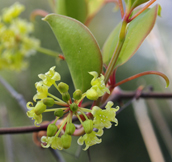
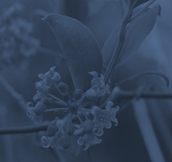 Smilax china Liliaceae
Smilax china Liliaceae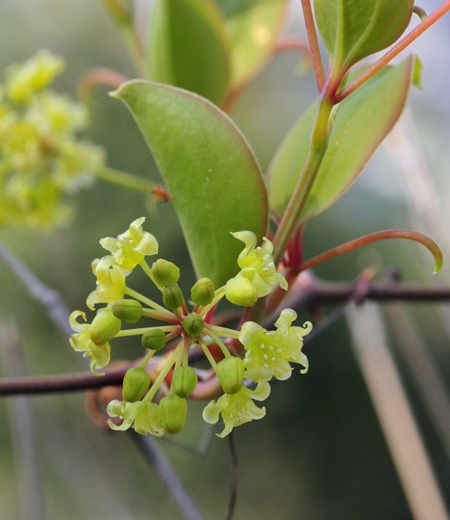 Deciduous woody vines (vines that sheds its leaves once in a year) found at forest edges, forests and grasslands in mountains. Twine adjacent tree. Have hard stems and bent at nodes and have spines. When monkey goes into vines, they might get stuck, hence the Japanese name Saru-tori-ibara, literally meaning monkey-catching brambles. Leaves are 3 to 12 cm long and round-shaped with pointed tip. Are thick, shiny and leaf vines are distinct. Are opposite and short petioles (stem to support leaves) have tendril. The blooming season is from April to May. Have male and female flowers. Bloom many small yellow-green flowers on inflorescence (flower stems) grow from petioles. Six petals are 6 mm oval-shaped and curled outward at tips. After flowering, bear 7 to 9 mm in diameter spherical fruits and turn red as they ripen.
Deciduous woody vines (vines that sheds its leaves once in a year) found at forest edges, forests and grasslands in mountains. Twine adjacent tree. Have hard stems and bent at nodes and have spines. When monkey goes into vines, they might get stuck, hence the Japanese name Saru-tori-ibara, literally meaning monkey-catching brambles. Leaves are 3 to 12 cm long and round-shaped with pointed tip. Are thick, shiny and leaf vines are distinct. Are opposite and short petioles (stem to support leaves) have tendril. The blooming season is from April to May. Have male and female flowers. Bloom many small yellow-green flowers on inflorescence (flower stems) grow from petioles. Six petals are 6 mm oval-shaped and curled outward at tips. After flowering, bear 7 to 9 mm in diameter spherical fruits and turn red as they ripen.
●Height Vines
●Place Trail 1, Ura-Takao -
Carpinus laxiflora Betulaceae
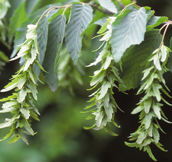
 Carpinus laxiflora Betulaceae
Carpinus laxiflora Betulaceae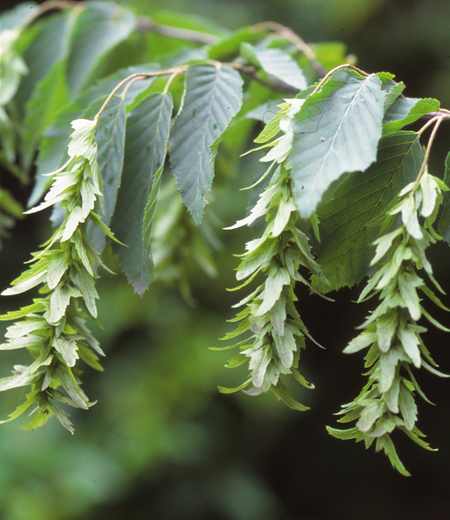 They are a deciduous tall tree that grows wild along the humid and fertile places along the mountain streams in the plain field and in the mountain area. Cortex is smooth feeling to touch and tinged with dark gray. The trunk grows to be about 30 cm wide, while the old trees have a string-like hollow grown. Around the time that new sprouts are about to shoot, they dangle lots of spikes of reddish male flowers, and all the more they turn into red autumn leaves. This is why they are named ‘Carpinus laxiflora’ (Aka-shide). ‘Shide’ is the paper that hangs from Sacred Rope, and the appearance of the seed to cover the spikes looks like the one of dangling Sacred Rope. The leaves are egged-shaped about 3 to 7 cm long with the sharp top, and with a sawtooth (sawtooth: Kyoshi, serrated edges like a saw- serrated edges at the tip of a leaf). Their characteristic of a leaf is thin and paper-like feeling to touch. Around the time of blossom seasons, the edge, the minutely serrated is about April to May. They are a monoecious plant and the flowers blossom about around the same time when the leaves sprout open out. Male flowers dangle from the branch that grew the previous year and female flowers are attached on the old branch.
They are a deciduous tall tree that grows wild along the humid and fertile places along the mountain streams in the plain field and in the mountain area. Cortex is smooth feeling to touch and tinged with dark gray. The trunk grows to be about 30 cm wide, while the old trees have a string-like hollow grown. Around the time that new sprouts are about to shoot, they dangle lots of spikes of reddish male flowers, and all the more they turn into red autumn leaves. This is why they are named ‘Carpinus laxiflora’ (Aka-shide). ‘Shide’ is the paper that hangs from Sacred Rope, and the appearance of the seed to cover the spikes looks like the one of dangling Sacred Rope. The leaves are egged-shaped about 3 to 7 cm long with the sharp top, and with a sawtooth (sawtooth: Kyoshi, serrated edges like a saw- serrated edges at the tip of a leaf). Their characteristic of a leaf is thin and paper-like feeling to touch. Around the time of blossom seasons, the edge, the minutely serrated is about April to May. They are a monoecious plant and the flowers blossom about around the same time when the leaves sprout open out. Male flowers dangle from the branch that grew the previous year and female flowers are attached on the old branch.
●Height about 10 to 15 m
●Place Trail 3 and 4, Mt.Inari -
Carpinus tschonoskii Betulaceae
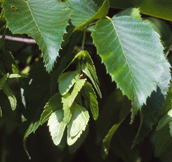
 Carpinus tschonoskii Betulaceae
Carpinus tschonoskii Betulaceae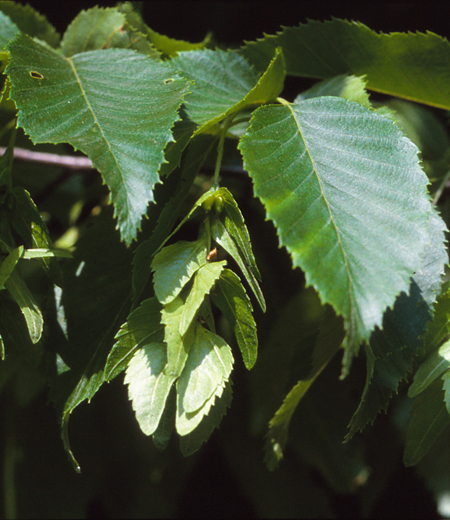 They are a deciduous tall tree that grows wild near human residences and can be ordinarily seen in the mountain areas. The trunk grows to be 30 cm wide, and cortex is smooth feeling to touch and tinged with gray-brown in color. When lichenes (Chiirui) such as molds and algae attach to them that causes many of the trees in vertical white-striped. This makes us to distinguish this species from the other hornbeam. A decade ago, people used to utilize them as fuelwood and charcoal. The leaves are egged-shaped or elliptically-shaped about 4 to 8 cm long. The leaves have lightly-coated with trichome on both surfaces with a sawtooth (sawtooth: Kyoshi, serrated edges like a saw- serrated edges at the tip of a leaf). The blossom seasons are about April to May and a monoecious plant. Simultaneously, new leaves sprout and flowers blossom, Pale yellowish male flowers dangle from the branch that grew the previous year and female flowers are attached on the new branch that extends on that year. The seeds are egged-shaped about 5 mm long, and are ablaze with yellow.
They are a deciduous tall tree that grows wild near human residences and can be ordinarily seen in the mountain areas. The trunk grows to be 30 cm wide, and cortex is smooth feeling to touch and tinged with gray-brown in color. When lichenes (Chiirui) such as molds and algae attach to them that causes many of the trees in vertical white-striped. This makes us to distinguish this species from the other hornbeam. A decade ago, people used to utilize them as fuelwood and charcoal. The leaves are egged-shaped or elliptically-shaped about 4 to 8 cm long. The leaves have lightly-coated with trichome on both surfaces with a sawtooth (sawtooth: Kyoshi, serrated edges like a saw- serrated edges at the tip of a leaf). The blossom seasons are about April to May and a monoecious plant. Simultaneously, new leaves sprout and flowers blossom, Pale yellowish male flowers dangle from the branch that grew the previous year and female flowers are attached on the new branch that extends on that year. The seeds are egged-shaped about 5 mm long, and are ablaze with yellow.
●Height about 20 m
●Place Trail 1 and 2, Trail 4, Mt.Inari -
Carpinus japanica Betulaceae
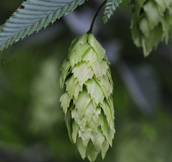
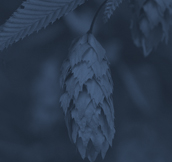 Carpinus japanica Betulaceae
Carpinus japanica Betulaceae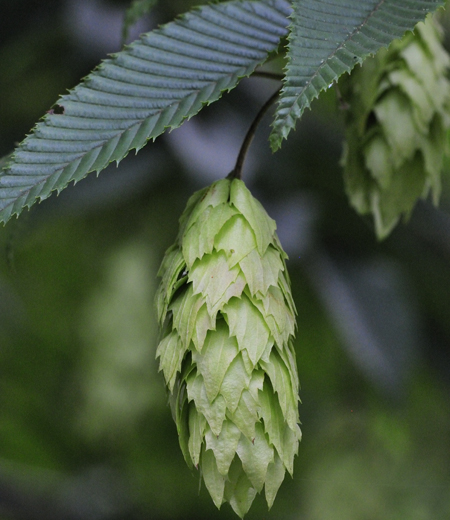 They are a deciduous tall tree that grows wild along the sunny valley in the mountain area. Cortex is tinged with blackish brown, when they are young trees the smooth feeling to touch, but adult trees get patterns of a welt on themselves. The trunk grows to be about 20 cm wide. The characteristic of the tree is the hardest among the group of hornbeam, which is the reason for another name ‘Carpinus japonica Blume’ or ‘Carpinus japonica’, is frequently utilized for wood for furniture and appliance material. The leaves are long elliptically-shaped about 5 to 10 cm long with the sharp top as well as with a sawtooth (sawtooth: Kyoshi, serrated edges like a saw-serrated edges at the tip of a leaf). The blossom seasons are about April. As they are a monoecious plant, the flowers bloom simultaneously around the time the leaves sprout. Spikes of male flowers, about 3 to 5 cm long, dangle from the branch that grew the previous year and female flowers are attached on the new branch. Each of the seeds is covered with bracts (Kahou) about 2 cm long, and gets matured about in October.
They are a deciduous tall tree that grows wild along the sunny valley in the mountain area. Cortex is tinged with blackish brown, when they are young trees the smooth feeling to touch, but adult trees get patterns of a welt on themselves. The trunk grows to be about 20 cm wide. The characteristic of the tree is the hardest among the group of hornbeam, which is the reason for another name ‘Carpinus japonica Blume’ or ‘Carpinus japonica’, is frequently utilized for wood for furniture and appliance material. The leaves are long elliptically-shaped about 5 to 10 cm long with the sharp top as well as with a sawtooth (sawtooth: Kyoshi, serrated edges like a saw-serrated edges at the tip of a leaf). The blossom seasons are about April. As they are a monoecious plant, the flowers bloom simultaneously around the time the leaves sprout. Spikes of male flowers, about 3 to 5 cm long, dangle from the branch that grew the previous year and female flowers are attached on the new branch. Each of the seeds is covered with bracts (Kahou) about 2 cm long, and gets matured about in October.
●Height about 10 to 15 m
●Place Trail 1 to 4, Mt.Inari -
Corylus sieboldiana Betulaceae
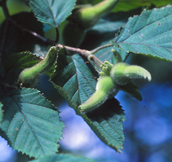
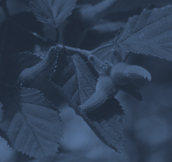 Corylus sieboldiana Betulaceae
Corylus sieboldiana Betulaceae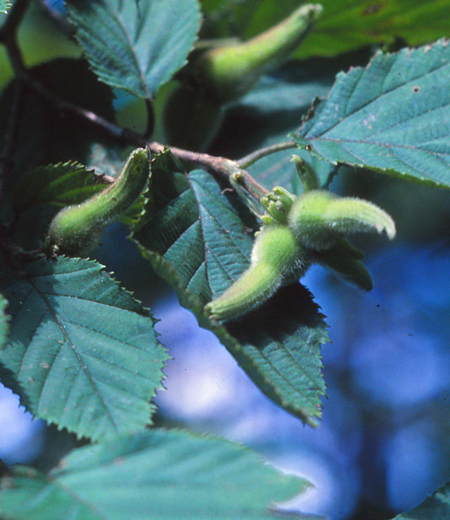 They are a deciduous shrub that grows wild in the mountain area. The trunk grows to be about 10 cm wide. Cortex is tinged with pale gray-brown and smooth to touch. They have both rounded lenticel and horizontally long lenticel. The leaves are wide egged-shaped about 3 to 11 cm long with the sharp top as well as with a scraggly finely sawtooth (sawtooth: Kyoshi, serrated edges like a saw- serrated edges at the tip of a leaf). The blossom seasons are about March to May. As they are a monoecious plant, the flowers bloom earlier than the leaves shoot. Spikes of male flowers dangle from the branch that grew the previous year, and the color is yellowish red-brown, about 3 to 13 cm long. Female flowers sprout at the upper branch than male flowers and they blossom with some red flowers gather in cluster. When the flowers wither, female flowers change themselves into rolled shape to hold the seeds with dense aculeus growing entirely. The top is unique long shape extending like beak, about 3 to 5 cm long. In October the seeds get matured to be edible.
They are a deciduous shrub that grows wild in the mountain area. The trunk grows to be about 10 cm wide. Cortex is tinged with pale gray-brown and smooth to touch. They have both rounded lenticel and horizontally long lenticel. The leaves are wide egged-shaped about 3 to 11 cm long with the sharp top as well as with a scraggly finely sawtooth (sawtooth: Kyoshi, serrated edges like a saw- serrated edges at the tip of a leaf). The blossom seasons are about March to May. As they are a monoecious plant, the flowers bloom earlier than the leaves shoot. Spikes of male flowers dangle from the branch that grew the previous year, and the color is yellowish red-brown, about 3 to 13 cm long. Female flowers sprout at the upper branch than male flowers and they blossom with some red flowers gather in cluster. When the flowers wither, female flowers change themselves into rolled shape to hold the seeds with dense aculeus growing entirely. The top is unique long shape extending like beak, about 3 to 5 cm long. In October the seeds get matured to be edible.
●Height about 2 to 3 m
●Place Trail 5 -
Quercus acuta Fagaceae
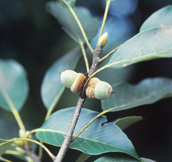
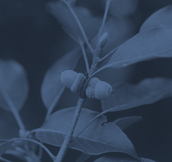 Quercus acuta Fagaceae
Quercus acuta Fagaceae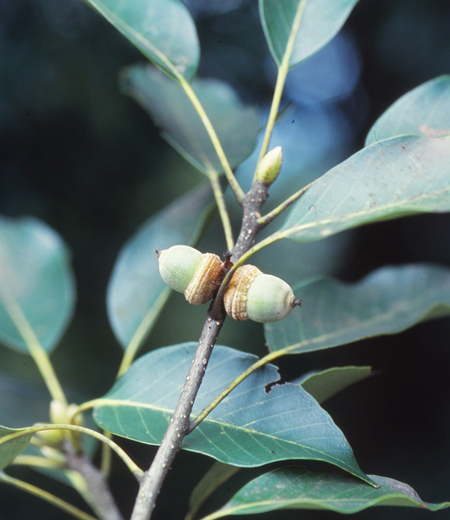 They are an evergreen tree that has green leaves all year round. As for large trees, the trunk grows to be about 2.5 m. They develop wild in the mountain areas as well as are planted in the parks, around human residents, and within Shinto shrine districts. Cortex is tinged with greenish gray-brown and seems a little dirty by bring peeled off scalelike. The characteristic is the tree is hard and tinged with noticing red, and therefore, they have got the name ‘Aka-gashi’. Their wood is utilized for material for building construction, for furniture and appliance material, and for wooden sword. The leaves are long elliptically-shaped about 7 to 15 cm long with the sharp top and a long stalk about 2 to 4 cm long, which are shiny and hard feeling to touch. The blossom seasons are about May to June and hermaphroditism plant (Shiyuudousyu). The spike of yellow male flower dangles from a new branch that extends in the spring, while female flower sprouts beside the leaf at the upper part of the branch. The seeds, ‘acorn’ (Donguri), get matured next autumn to be edible.
They are an evergreen tree that has green leaves all year round. As for large trees, the trunk grows to be about 2.5 m. They develop wild in the mountain areas as well as are planted in the parks, around human residents, and within Shinto shrine districts. Cortex is tinged with greenish gray-brown and seems a little dirty by bring peeled off scalelike. The characteristic is the tree is hard and tinged with noticing red, and therefore, they have got the name ‘Aka-gashi’. Their wood is utilized for material for building construction, for furniture and appliance material, and for wooden sword. The leaves are long elliptically-shaped about 7 to 15 cm long with the sharp top and a long stalk about 2 to 4 cm long, which are shiny and hard feeling to touch. The blossom seasons are about May to June and hermaphroditism plant (Shiyuudousyu). The spike of yellow male flower dangles from a new branch that extends in the spring, while female flower sprouts beside the leaf at the upper part of the branch. The seeds, ‘acorn’ (Donguri), get matured next autumn to be edible.
●Height about 15 to 20 m
●Place Trail 1 to 3 -
Quercus glauca Fagaceae
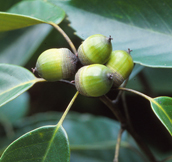
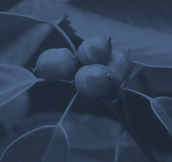 Quercus glauca Fagaceae
Quercus glauca Fagaceae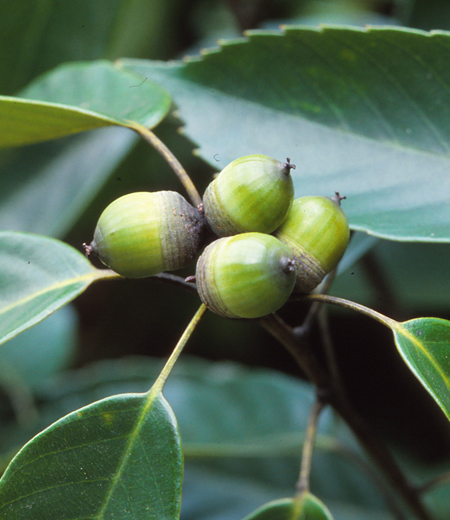 They are an evergreen tree that grows wild in the mountains. Cortex is greenish dark gray in color with hollows and small cracks. The trunk grows to be about 60 cm long, and when it gets older, the hollows become vertically deeper. They are often planted for wood hedges and garden trees; the wood is utilized for material for building construction, for furniture and appliance material as well as raw wood to raise shiitake mushrooms. The leaves are long elliptically-shaped about 7 to 12 cm long with the sharp top and with a rather larger sawtooth (Kyoshi: tooth-like rough part like a saw at the root of a leaf) at the upper part of edge. The back of the leaf is waxlike white and bears finely dense trichome. The blossom seasons are about April to May and hermaphroditism plant (Shiyuudousyu).The spike of male flower, about 5 to 10 cm long, dangles from a new branch; while 1 to 3 of female flowers sprout beside the leaf at the upper part of the branch. The seeds, ‘acorn’ (Donguri), are rounded egged-shaped about 1.5 to 2 cm long, get matured on the year of blossoms.
They are an evergreen tree that grows wild in the mountains. Cortex is greenish dark gray in color with hollows and small cracks. The trunk grows to be about 60 cm long, and when it gets older, the hollows become vertically deeper. They are often planted for wood hedges and garden trees; the wood is utilized for material for building construction, for furniture and appliance material as well as raw wood to raise shiitake mushrooms. The leaves are long elliptically-shaped about 7 to 12 cm long with the sharp top and with a rather larger sawtooth (Kyoshi: tooth-like rough part like a saw at the root of a leaf) at the upper part of edge. The back of the leaf is waxlike white and bears finely dense trichome. The blossom seasons are about April to May and hermaphroditism plant (Shiyuudousyu).The spike of male flower, about 5 to 10 cm long, dangles from a new branch; while 1 to 3 of female flowers sprout beside the leaf at the upper part of the branch. The seeds, ‘acorn’ (Donguri), are rounded egged-shaped about 1.5 to 2 cm long, get matured on the year of blossoms.
●Height about 15 to 20 m
●Place Trail 1 to 3 -
Fagus japonica Fagaceae
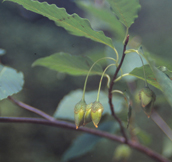
 Fagus japonica Fagaceae
Fagus japonica Fagaceae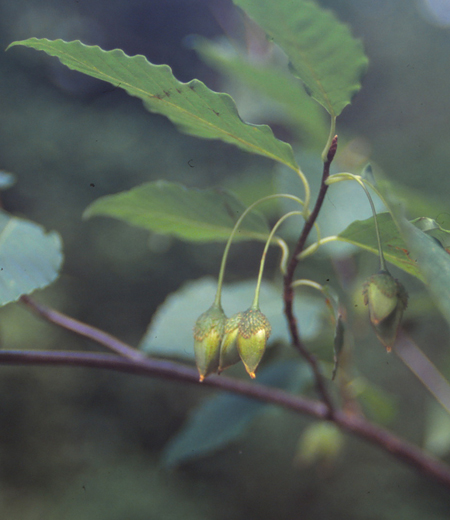 They are a deciduous shrub that is representative of the trees at Mt. Takao. As the same case with beech trees, they are utilized for materials to make household furniture, apparatus, and resources to build ships. They are, however, crowned in their name ‘Inu’ (a dog) because they are inferior in quality to beech trees. Furthermore, compared to the beech trees, they are tinged with black, It is often that people call beech trees, as ‘Shiro-buna’ (white beech trees), while people call Fagus japonica. As ‘Kuro-buna’ (black beech trees). The trunk grows to be 70 cm wide and shoots a new sprout called ‘Hikobae’ (buds from the base of beech trees) from the root. The leaves are long elliptically-shaped with wavelike sawtooth (Kyoshi: tooth-like rough part like a saw at the root of a leaf) at the edge. Young leaves bear long and soft trichome, but once they grow adult ones the trichome disappears. The blossom seasons are about April to May and hermaphroditism plant (Shiyuudousyu). No sooner the leaves are open than a new spike of male flowers like a hanging fuzzball dangles from the new branch and female flowers sprout at the upper part of the branch. They bear triangle-shaped seeds in autumn.
They are a deciduous shrub that is representative of the trees at Mt. Takao. As the same case with beech trees, they are utilized for materials to make household furniture, apparatus, and resources to build ships. They are, however, crowned in their name ‘Inu’ (a dog) because they are inferior in quality to beech trees. Furthermore, compared to the beech trees, they are tinged with black, It is often that people call beech trees, as ‘Shiro-buna’ (white beech trees), while people call Fagus japonica. As ‘Kuro-buna’ (black beech trees). The trunk grows to be 70 cm wide and shoots a new sprout called ‘Hikobae’ (buds from the base of beech trees) from the root. The leaves are long elliptically-shaped with wavelike sawtooth (Kyoshi: tooth-like rough part like a saw at the root of a leaf) at the edge. Young leaves bear long and soft trichome, but once they grow adult ones the trichome disappears. The blossom seasons are about April to May and hermaphroditism plant (Shiyuudousyu). No sooner the leaves are open than a new spike of male flowers like a hanging fuzzball dangles from the new branch and female flowers sprout at the upper part of the branch. They bear triangle-shaped seeds in autumn.
●Height about 20 to 25 m
●Place Trail 1 and 2, Trail 4 -
Quercus salicina Fagaceae
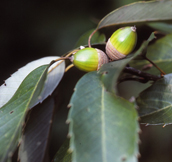
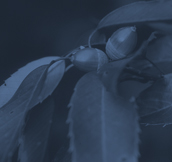 Quercus salicina Fagaceae
Quercus salicina Fagaceae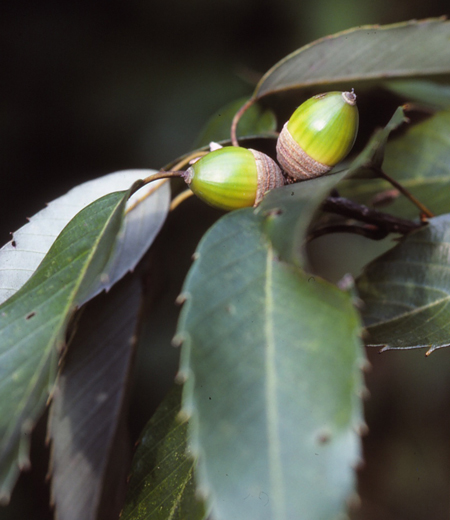 They are an evergreen tree that grows wild in the mountains. As the back of the leaves is white as if it is waxlike, they are named ‘Uraziro-gashi’ (Quercus salicina). Cortex is dark gray color and small bumpy lenticels and hollows are distinctive to show up. The trunk grows to be about 80 cm wide with new branches bearing dense trichome. The wood is utilized for material for building construction, for furniture and appliance material. The leaves are long elliptically-shaped about 7 to 11 cm long, shiny and hard feeling to touch as if it is leather, with the sharp top and with a rather larger sawtooth (Kyoshi: tooth-like rough part like a saw at the root of a leaf) at the edge. Young leaves bear soft trichome on both surfaces, but the trichome disappears once the leaves grow old. The blossom season is about May and hermaphroditism plant (Shiyuudousyu). The spike about 4 to 6 cm long of male flower dangles from a new branch; while female flowers sprout beside the leaf at the upper part of the branch. The seeds, ‘acorn’ (Donguri), are egged-shaped about 1.5 to 2 cm long, get matured next autumn.
They are an evergreen tree that grows wild in the mountains. As the back of the leaves is white as if it is waxlike, they are named ‘Uraziro-gashi’ (Quercus salicina). Cortex is dark gray color and small bumpy lenticels and hollows are distinctive to show up. The trunk grows to be about 80 cm wide with new branches bearing dense trichome. The wood is utilized for material for building construction, for furniture and appliance material. The leaves are long elliptically-shaped about 7 to 11 cm long, shiny and hard feeling to touch as if it is leather, with the sharp top and with a rather larger sawtooth (Kyoshi: tooth-like rough part like a saw at the root of a leaf) at the edge. Young leaves bear soft trichome on both surfaces, but the trichome disappears once the leaves grow old. The blossom season is about May and hermaphroditism plant (Shiyuudousyu). The spike about 4 to 6 cm long of male flower dangles from a new branch; while female flowers sprout beside the leaf at the upper part of the branch. The seeds, ‘acorn’ (Donguri), are egged-shaped about 1.5 to 2 cm long, get matured next autumn.
●Height about 15 to 20 m
●Place Trail 1 to 3 -
Castanea crenata Fagaceae
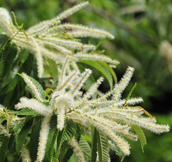
 Castanea crenata Fagaceae
Castanea crenata Fagaceae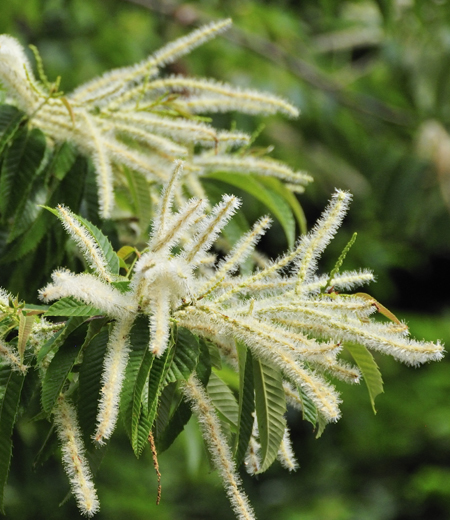 They are a deciduous tall tree that grows wild in the mountain areas and in the hilly district. The seeds are edible, and so are planted as orchard trees. Cortex is grayish black and split vertically deeper. The trunk grows to be about 1 m wide. The wood is hard and has the quality to last long, therefore, is utilized for bedding material for building houses, materials for building construction, for craftwork as well as raw wood to raise shiitake mushrooms. The leaves are thin and long elliptically-shaped about 7 to 15 cm long with the sharp top and with sawtooth (Kyoshi: tooth-like rough part like a saw at the root of a leaf) at the edge. The blossom seasons are about June to July and hermaphroditism plant (Shiyuudousyu). The spike, about 15 cm long, of male flowers sprouts beside the leaves of new branches dangles, while 1 to 2 of female flowers sprout at the root of male flowers. 3 of the seedlings are usually covered with thorny Tinea translucens (Iga: clothes moth). The seedlings get matured to dark brown in autumn on the year of the blossoms.
They are a deciduous tall tree that grows wild in the mountain areas and in the hilly district. The seeds are edible, and so are planted as orchard trees. Cortex is grayish black and split vertically deeper. The trunk grows to be about 1 m wide. The wood is hard and has the quality to last long, therefore, is utilized for bedding material for building houses, materials for building construction, for craftwork as well as raw wood to raise shiitake mushrooms. The leaves are thin and long elliptically-shaped about 7 to 15 cm long with the sharp top and with sawtooth (Kyoshi: tooth-like rough part like a saw at the root of a leaf) at the edge. The blossom seasons are about June to July and hermaphroditism plant (Shiyuudousyu). The spike, about 15 cm long, of male flowers sprouts beside the leaves of new branches dangles, while 1 to 2 of female flowers sprout at the root of male flowers. 3 of the seedlings are usually covered with thorny Tinea translucens (Iga: clothes moth). The seedlings get matured to dark brown in autumn on the year of the blossoms.
●Height 15 to 20 m
●Place Oku-Takao -
Quercus serrata Fagaceae
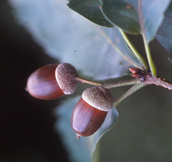
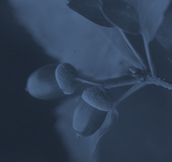 Quercus serrata Fagaceae
Quercus serrata Fagaceae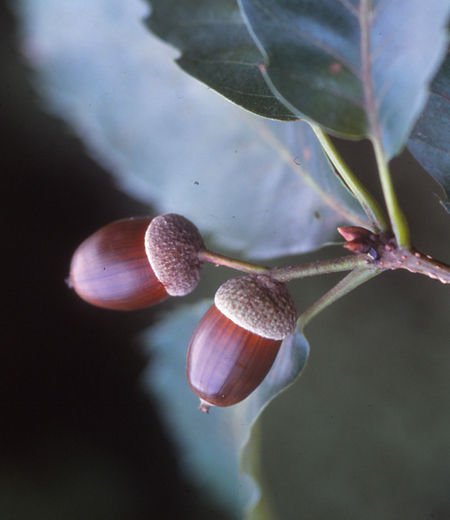 They are a deciduous tall tree that grows wild in the mountain areas. Cortex is greenish-tinged black color and smooth feeling to touch with lenticels in line vertically.
They are a deciduous tall tree that grows wild in the mountain areas. Cortex is greenish-tinged black color and smooth feeling to touch with lenticels in line vertically.
When they grow older, many of them are split vertically shallow and rough feeling to touch. The trunk grows to be about 60 cm wide. They are often planted for garden trees and roadside trees as well as are utilized for material for building construction, for music device and musical instrument material, and raw wood to raise shiitake mushrooms. The leaves are long elliptically-shaped about 5 to 15 cm long with the sharp top and with sawtooth (Kyoshi: tooth-like rough part like a saw at the root of a leaf) at the edge. The leaves are hard feeling to touch and the back is tinged with white. The blossom seasons are around May and hermaphroditism plant (Shiyuudousyu). The spike of thin and long male flower about 2 to 6 cm long sprouts beside the branches that newly grow and extended the previous year dangles, while 3 to 4 of female flowers sprout beside the upper leaf of a new branch. The seeds, ‘acorn’ (Donguri), are egged-shaped about 2 cm long, get matured next autumn.
●Height about 15 to 20 m
●Place Trail 1 to 5, Mt.Inari -
Quercus myrsinaefolia Fagaceae
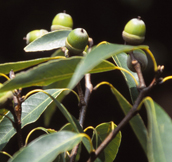
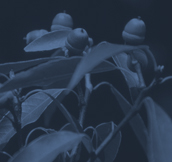 Quercus myrsinaefolia Fagaceae
Quercus myrsinaefolia Fagaceae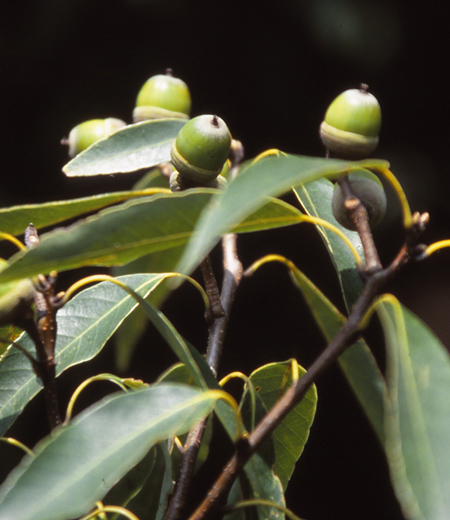 They are a deciduous tall tree that grows wild in the mountain areas. Cortex is greenish-tinged black color and smooth feeling to touch with lenticels in line vertically. When they grow older, many of them are split vertically shallow and rough feeling to touch. The trunk grows to be about 80 cm wide. They are often planted for garden trees and roadside trees as well as are utilized for material for building construction, for music device and musical instrument material, and raw wood to raise shiitake mushrooms. The leaves are long elliptically-shaped about 7 to 14 cm long with the sharp top and with sawtooth (Kyoshi: tooth-like rough part like a saw at the root of a leaf) at the edge. The leaves are hard feeling to touch and the back is tinged with white. The blossom seasons are around May and hermaphroditism plant (Shiyuudousyu). The spike of thin and long male flower about 5 to 12 cm long sprouts beside the branches that newly grow and extended the previous year dangles, while 3 to 4 of female flowers sprout beside the upper leaf of a new branch. The seeds, ‘acorn’ (Donguri), are egged-shaped about 1.5 cm long, get matured next autumn.
They are a deciduous tall tree that grows wild in the mountain areas. Cortex is greenish-tinged black color and smooth feeling to touch with lenticels in line vertically. When they grow older, many of them are split vertically shallow and rough feeling to touch. The trunk grows to be about 80 cm wide. They are often planted for garden trees and roadside trees as well as are utilized for material for building construction, for music device and musical instrument material, and raw wood to raise shiitake mushrooms. The leaves are long elliptically-shaped about 7 to 14 cm long with the sharp top and with sawtooth (Kyoshi: tooth-like rough part like a saw at the root of a leaf) at the edge. The leaves are hard feeling to touch and the back is tinged with white. The blossom seasons are around May and hermaphroditism plant (Shiyuudousyu). The spike of thin and long male flower about 5 to 12 cm long sprouts beside the branches that newly grow and extended the previous year dangles, while 3 to 4 of female flowers sprout beside the upper leaf of a new branch. The seeds, ‘acorn’ (Donguri), are egged-shaped about 1.5 cm long, get matured next autumn.
●Height about 15 to20 m
●Place Trail 1 to 3 -
Castanopsis sieboldii Fagaceae
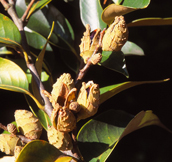
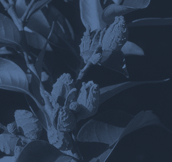 Castanopsis sieboldii Fagaceae
Castanopsis sieboldii Fagaceae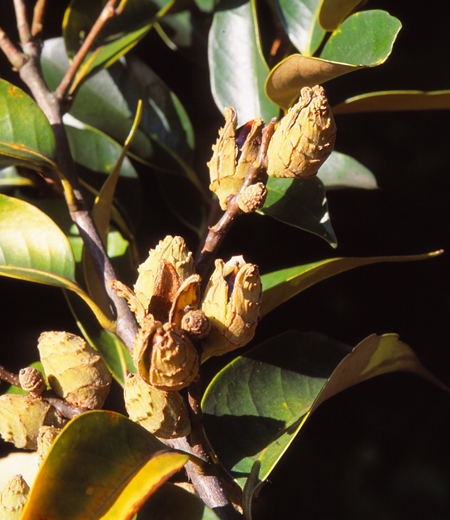 They are a evergreen tall tree that grows wild in the mountain areas, which is called ‘beech tree of genus Castanopsis‘ in general. Cortex is blackish brown color and is vertically split deeper. The trunk grows to be about 1 meter wide. They are often planted for garden trees and windbreak trees as well as are utilized for material for building construction, for furniture and appliance material, and raw wood to raise shiitake mushrooms. The leaves are wide elliptically-shaped about 6 to 15 cm long with a half of the edge bearing sawtooth (Kyoshi: tooth-like rough part like a saw at the root of a leaf) and with the back bearing finely minute trichome. The blossom seasons are about May to June and hermaphroditism plant (Shiyuudousyu). The spike of pale yellowish-tinged male flower about 8 to 12 cm long dangles from a new branch, while several of female flowers sprout beside the leaf at the upper part of the branch. When the flowers are in full bloom, young leaves in yellow color show up like growing thick and strong odor can be smelled. The seeds, ‘acorn’ (Donguri), are elliptically-shaped about 2 cm long, get matured next autumn, and then can be edible.
They are a evergreen tall tree that grows wild in the mountain areas, which is called ‘beech tree of genus Castanopsis‘ in general. Cortex is blackish brown color and is vertically split deeper. The trunk grows to be about 1 meter wide. They are often planted for garden trees and windbreak trees as well as are utilized for material for building construction, for furniture and appliance material, and raw wood to raise shiitake mushrooms. The leaves are wide elliptically-shaped about 6 to 15 cm long with a half of the edge bearing sawtooth (Kyoshi: tooth-like rough part like a saw at the root of a leaf) and with the back bearing finely minute trichome. The blossom seasons are about May to June and hermaphroditism plant (Shiyuudousyu). The spike of pale yellowish-tinged male flower about 8 to 12 cm long dangles from a new branch, while several of female flowers sprout beside the leaf at the upper part of the branch. When the flowers are in full bloom, young leaves in yellow color show up like growing thick and strong odor can be smelled. The seeds, ‘acorn’ (Donguri), are elliptically-shaped about 2 cm long, get matured next autumn, and then can be edible.
●Height about 20 to 30 m
●Place Trail 1 to 3 -
Quercus sessilifolia Fagaceae
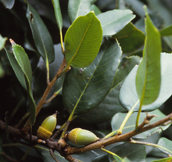
 Quercus sessilifolia Fagaceae
Quercus sessilifolia Fagaceae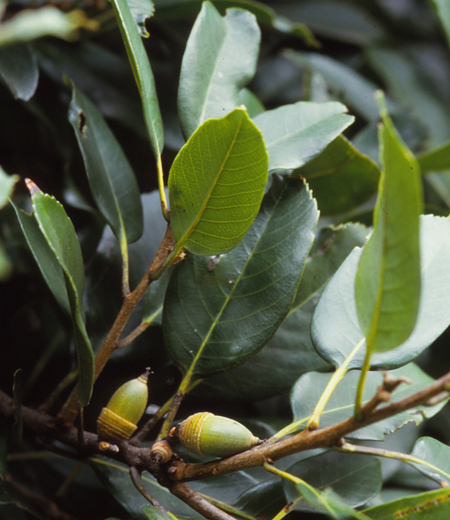 They are a deciduous tall tree that grows wild in the mountain areas. Cortex is blackish brown color and is vertically split shallow. The trunk grows to be about 60 cm wide. The leaves grow gathering at the limb of the branch, of which appearance is compared as a shuttlecock of battledore (Hanetsuki). This is why they are named ‘Quercus sessilifolia’ (Tsukubane-gashi). The leaves are wide egged-shaped about 5 to 10 cm long with the sharp top and hard feeling to touch. The surfaces of the leaves are shiny, while the back is pale green color. Young leaves bear short trichome with the edge rolled inward and also sawtooth (Kyoshi: tooth-like rough part like a saw at the root of a leaf) .The blossom season is about April to May and hermaphroditism plant (Shiyuudousyu). The spike of yellowish green male flowers, about 5 to 7 cm long, dangles from a new branch, while 3 to 4 of female flowers sprout beside the upper leaf of the branch. The seeds, ‘Don-guri’, (acorn) are egged-shaped about 1.5 cm long.
They are a deciduous tall tree that grows wild in the mountain areas. Cortex is blackish brown color and is vertically split shallow. The trunk grows to be about 60 cm wide. The leaves grow gathering at the limb of the branch, of which appearance is compared as a shuttlecock of battledore (Hanetsuki). This is why they are named ‘Quercus sessilifolia’ (Tsukubane-gashi). The leaves are wide egged-shaped about 5 to 10 cm long with the sharp top and hard feeling to touch. The surfaces of the leaves are shiny, while the back is pale green color. Young leaves bear short trichome with the edge rolled inward and also sawtooth (Kyoshi: tooth-like rough part like a saw at the root of a leaf) .The blossom season is about April to May and hermaphroditism plant (Shiyuudousyu). The spike of yellowish green male flowers, about 5 to 7 cm long, dangles from a new branch, while 3 to 4 of female flowers sprout beside the upper leaf of the branch. The seeds, ‘Don-guri’, (acorn) are egged-shaped about 1.5 cm long.
●Height about 15 to 20 m
●Place Trail 1 to 3 -
Zelkova serrata Ulmaceae
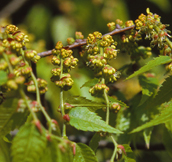
 Zelkova serrata Ulmaceae
Zelkova serrata Ulmaceae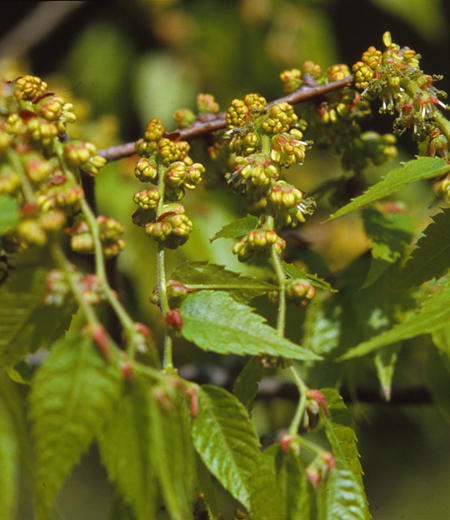 They are an evergreen tree that grows wild around hilly district and low mountain areas. Cortex is grayish white in color and smooth feeling to touch with many small rounded lenticels. Cortexes of the old trees are peeled off to be scale-like The trunk grows to be 1.5 m wide. The branch is tinged with dark brown, finely buckle up with minute white trichome. Their wood building materials is beautiful for the wood grain and accurate with no wood warps, and so is also utilized for construction of temples and shrines, rice mortar, lacquered tableware, and others. The leaves are thin and long egged-shaped about 3 - 7 centimeters long, about 1 to 2.5 cm wide with the sharp top as well as a sawtooth (Kyoshi: tooth-like rough part like a saw at the root of a leaf) at the edge. Their characteristic is the leaves are shiny on the surface and rough feeling to touch. The blossom seasons are about April to May and monoecious plant. Small female flowers gather to bloom beside the bottom leaf of a new branch, while 1 to 3 of female flowers bloom at the upper branch. The seeds are a distorted angulated spherical shape about 4 to 5 mm in diameter, and get matured in October into dark brown color.
They are an evergreen tree that grows wild around hilly district and low mountain areas. Cortex is grayish white in color and smooth feeling to touch with many small rounded lenticels. Cortexes of the old trees are peeled off to be scale-like The trunk grows to be 1.5 m wide. The branch is tinged with dark brown, finely buckle up with minute white trichome. Their wood building materials is beautiful for the wood grain and accurate with no wood warps, and so is also utilized for construction of temples and shrines, rice mortar, lacquered tableware, and others. The leaves are thin and long egged-shaped about 3 - 7 centimeters long, about 1 to 2.5 cm wide with the sharp top as well as a sawtooth (Kyoshi: tooth-like rough part like a saw at the root of a leaf) at the edge. Their characteristic is the leaves are shiny on the surface and rough feeling to touch. The blossom seasons are about April to May and monoecious plant. Small female flowers gather to bloom beside the bottom leaf of a new branch, while 1 to 3 of female flowers bloom at the upper branch. The seeds are a distorted angulated spherical shape about 4 to 5 mm in diameter, and get matured in October into dark brown color.
●Height about 20 to 30 m
●Place Trail 1 to 4, Trail 6, Ura-Takao -
Euptelea polyandra Eupteleaceae
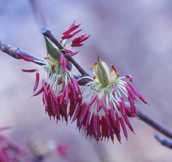
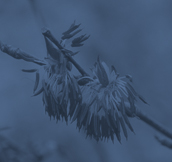 Euptelea polyandra Eupteleaceae
Euptelea polyandra Eupteleaceae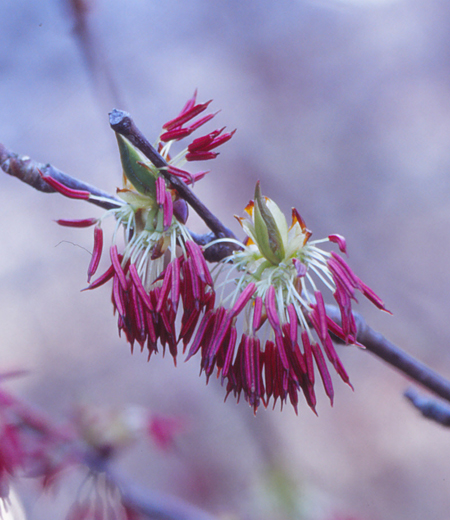 Deciduous small trees found in wet areas including streamside in mountains. Barks are bright brown and smooth. Trunk grows up to 30 cm. Wide and long lenticels (an opening that allows gases to be exchanged between air and the inner tissues of a plant) are distinct on young tree. It cracks to become net-like appearance for old trees. Is similar to cherry blossoms but they are not in the same group. Leaves are 6 to 12 cm long and round shaped with tips extended and whitish on the back. The blooming season is from March to April and bloom five to twelve dark red flowers at the tips of branches before leaves open. Have no petals or calyx and many stamens about 7 mm long are dropping and have pistils at the base. Fruits are odd-shaped and dropping on fruits stems. Turn yellow in autumn and seeds are flown by the wind.
Deciduous small trees found in wet areas including streamside in mountains. Barks are bright brown and smooth. Trunk grows up to 30 cm. Wide and long lenticels (an opening that allows gases to be exchanged between air and the inner tissues of a plant) are distinct on young tree. It cracks to become net-like appearance for old trees. Is similar to cherry blossoms but they are not in the same group. Leaves are 6 to 12 cm long and round shaped with tips extended and whitish on the back. The blooming season is from March to April and bloom five to twelve dark red flowers at the tips of branches before leaves open. Have no petals or calyx and many stamens about 7 mm long are dropping and have pistils at the base. Fruits are odd-shaped and dropping on fruits stems. Turn yellow in autumn and seeds are flown by the wind.
●Height about 5 to 15 m
●Place Trail 4, Jyataki, Oku-Takao -
Actinidia polygama(Silvervine) Actinidiaceae
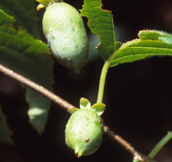
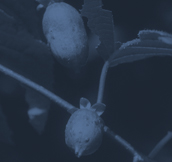 Actinidia polygama(Silvervine) Actinidiaceae
Actinidia polygama(Silvervine) Actinidiaceae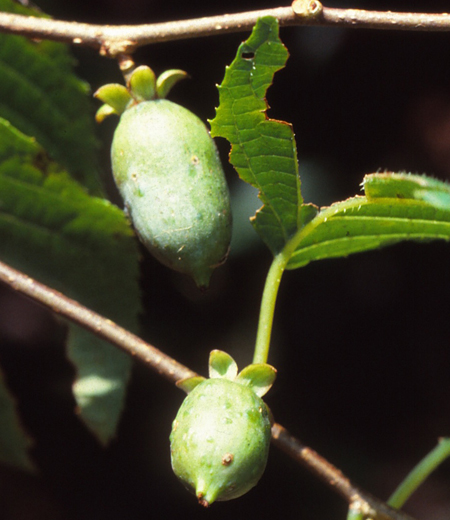 Deciduous woody vines found in forest edges from hills to mountains. Twine adjacent plants and become 2 to 5 m. Barks are brown, oval-shaped with many lenticels (an opening that allows gases to be exchanged between air and the inner tissues of a plant). Leaves are 6 to 10 cm long, wide egg-shaped. The ones on upper parts of stems turn to white on surface. Have stems for bisexual flowers and male flowers. Flowers are about 2 cm in diameter and egg-like shaped with five white petals resembling ume flowers. Fruits are 2 to 2.5 cm in diameter and oval-shaped with bill-like pointed tip. Have many seeds inside. Green seeds turn to orange in October as they ripen. The Japanese name Matatabi was named because they can travel again. (Mata-tabi-ga-dekiru in Japanese). But another theory is more wide-spread, that it was named after the word in Ainu language Matatabu.
Deciduous woody vines found in forest edges from hills to mountains. Twine adjacent plants and become 2 to 5 m. Barks are brown, oval-shaped with many lenticels (an opening that allows gases to be exchanged between air and the inner tissues of a plant). Leaves are 6 to 10 cm long, wide egg-shaped. The ones on upper parts of stems turn to white on surface. Have stems for bisexual flowers and male flowers. Flowers are about 2 cm in diameter and egg-like shaped with five white petals resembling ume flowers. Fruits are 2 to 2.5 cm in diameter and oval-shaped with bill-like pointed tip. Have many seeds inside. Green seeds turn to orange in October as they ripen. The Japanese name Matatabi was named because they can travel again. (Mata-tabi-ga-dekiru in Japanese). But another theory is more wide-spread, that it was named after the word in Ainu language Matatabu.
●Height Vines
●Place Trail 1, Trail 4, Trail 6, Jyataki, Ura-Takao -
Magnolia praecocissima Magnoliaceae
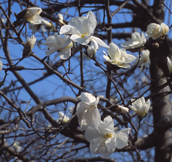
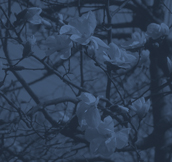 Magnolia praecocissima Magnoliaceae
Magnolia praecocissima Magnoliaceae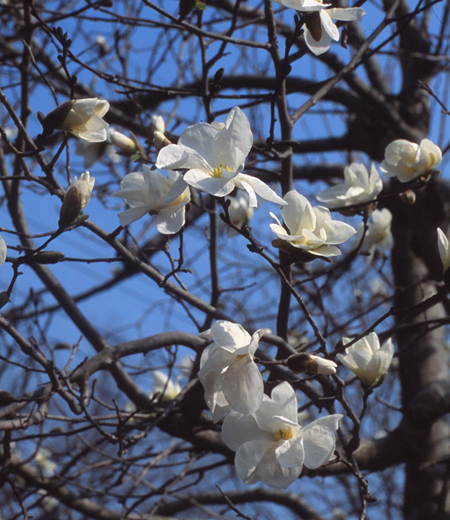 They are a deciduous tall tree that grows wild around hilly district to the mountain areas. Cortex is smooth feeling to touch and whitish gray color with small lenticels. The trunk grows to be about 20 to 30 cm wide. New branches are tinged with purplish green. The leaves are wide egged-shaped, about 6 to 15 cm long and about 3 to 6 cm wide, thin and machine-made paper feeling to touch. When they are kneaded they smell strong odor, and when we bite them they taste bitter. The blossom seasons are March to May, white flowers with sweet smell blossom before the leaves are open. The flower is about 6 to 10 cm in diameter with 6 flower petals. The portion at the root of the flower is tinged with red. The characteristic is 1 small leaf grows below the flower. The seeds are aggregate fruit (Syugo-ka) which consists of many small seedlings, thin uneven membrane-enclosed surface, about 7 to 15 cm long. It is said that people use Japanese name to resemble fists. When the seeds get matured in September to October, they get vertically split to dangle red seedlings.
They are a deciduous tall tree that grows wild around hilly district to the mountain areas. Cortex is smooth feeling to touch and whitish gray color with small lenticels. The trunk grows to be about 20 to 30 cm wide. New branches are tinged with purplish green. The leaves are wide egged-shaped, about 6 to 15 cm long and about 3 to 6 cm wide, thin and machine-made paper feeling to touch. When they are kneaded they smell strong odor, and when we bite them they taste bitter. The blossom seasons are March to May, white flowers with sweet smell blossom before the leaves are open. The flower is about 6 to 10 cm in diameter with 6 flower petals. The portion at the root of the flower is tinged with red. The characteristic is 1 small leaf grows below the flower. The seeds are aggregate fruit (Syugo-ka) which consists of many small seedlings, thin uneven membrane-enclosed surface, about 7 to 15 cm long. It is said that people use Japanese name to resemble fists. When the seeds get matured in September to October, they get vertically split to dangle red seedlings.
●Height about 10 to 20 m
●Place Oku-Takao -
Magnolia hypoleuca Magnoliaceae
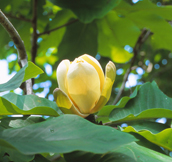
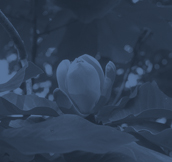 Magnolia hypoleuca Magnoliaceae
Magnolia hypoleuca Magnoliaceae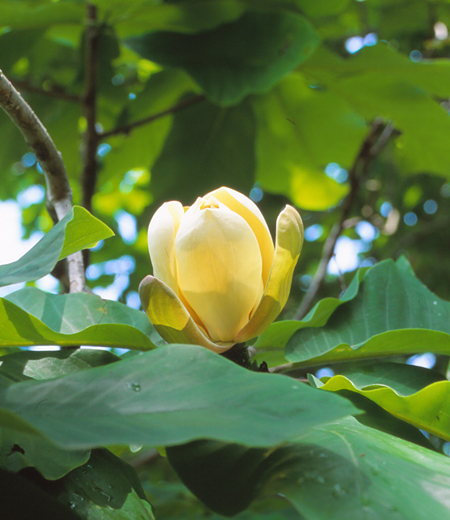 They are a deciduous tall tree that grows wild around hilly district to the mountain areas. Cortex is smooth feeling to touch and gray color with many small lenticels. The trunk grows to be about 1 m wide. The wood is so accurate that it is utilized to make for house furnishings and wooden clogs. The leaves are large, about 20 to 40 cm long, about 10 to 25 cm wide, long elliptically-shaped like an inverted egg, and thick and hard. The leaves are also called ‘Hooba’ (leaves used for ocal cuisines at Hida Takayama region, Gifu Prefecture) and people have used them to wrap the food and as dishes instead of plates since decades ago. The flowers are also large about 15 cm long, white flowers tinged with yellow blossom upwards at the limb in May to June. Their sweet smell is so strong that people around them can enjoy it. The seeds are aggregate fruit (Syugo-ka) which consists of many small seedlings, long elliptically-shaped, and about 10 to 15 cm long. When each of the seeds get matured, they are split to shoot 2 red seedlings.
They are a deciduous tall tree that grows wild around hilly district to the mountain areas. Cortex is smooth feeling to touch and gray color with many small lenticels. The trunk grows to be about 1 m wide. The wood is so accurate that it is utilized to make for house furnishings and wooden clogs. The leaves are large, about 20 to 40 cm long, about 10 to 25 cm wide, long elliptically-shaped like an inverted egg, and thick and hard. The leaves are also called ‘Hooba’ (leaves used for ocal cuisines at Hida Takayama region, Gifu Prefecture) and people have used them to wrap the food and as dishes instead of plates since decades ago. The flowers are also large about 15 cm long, white flowers tinged with yellow blossom upwards at the limb in May to June. Their sweet smell is so strong that people around them can enjoy it. The seeds are aggregate fruit (Syugo-ka) which consists of many small seedlings, long elliptically-shaped, and about 10 to 15 cm long. When each of the seeds get matured, they are split to shoot 2 red seedlings.
●Height about 20 to 30 m
●Place Trail 4, Mt.Inari, Oku-Takao -
Lindera praecox Lauraceae

 Lindera praecox Lauraceae
Lindera praecox Lauraceae They are a deciduous small trees or shrubs that grow wild through mountains and fields. They grow like bushy and mostly we can see them auch a humid places as along the mountain strams. Cortex is tinged with gray-brown and small round lenticel show off. The characteristic o the tree is tough and strong, therefore, people used to utilize thie tree as a substitute for sticks and round or lattice-type snowshoes that are made of bamboo. A part of the name ‘Chan’ means ‘bituminous rock’ (Rekisei: substances such as natural tar) and entirely contains oils, so that in ancient times people use this oils extracted from the seeds and cortex for lighting. This is how they are named. The leaves are elliptically-shaped about 4 to 9 cm long, about 2 to 4 cm wide with the sharp topand the leafstalk is tinged with red. The blossom seasons are about March to April and a dioecious plant (Shiyuuisyu). They bear 3 to 5 f small yellow flowers on the branch that extended the previous year. Both a male flower and a female flower have 6 flower petals each, about 2 mm long. The seeds that are in a spherical shape about 1.5 cm in diameter get matured to yellowish brown in September to October.
They are a deciduous small trees or shrubs that grow wild through mountains and fields. They grow like bushy and mostly we can see them auch a humid places as along the mountain strams. Cortex is tinged with gray-brown and small round lenticel show off. The characteristic o the tree is tough and strong, therefore, people used to utilize thie tree as a substitute for sticks and round or lattice-type snowshoes that are made of bamboo. A part of the name ‘Chan’ means ‘bituminous rock’ (Rekisei: substances such as natural tar) and entirely contains oils, so that in ancient times people use this oils extracted from the seeds and cortex for lighting. This is how they are named. The leaves are elliptically-shaped about 4 to 9 cm long, about 2 to 4 cm wide with the sharp topand the leafstalk is tinged with red. The blossom seasons are about March to April and a dioecious plant (Shiyuuisyu). They bear 3 to 5 f small yellow flowers on the branch that extended the previous year. Both a male flower and a female flower have 6 flower petals each, about 2 mm long. The seeds that are in a spherical shape about 1.5 cm in diameter get matured to yellowish brown in September to October.
●Height about 3 to 6 m
●Place Trail 1, Trail 3 to 6, Mt.Inari, Ura-Takao, Minami-Takao -
Lindera umbellata Lauraceae
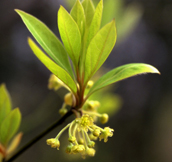
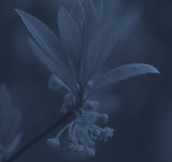 Lindera umbellata Lauraceae
Lindera umbellata Lauraceae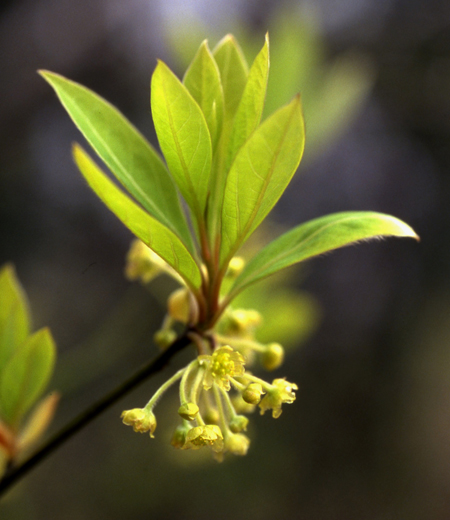 They are a deciduous shrub that grows wild at grove of mixed trees at the mountain areas. Cortex tinged with gray-brown is smooth feeling to touch and round lenticel stands out. The trunk grows to be about 10 cm wide. As young branches are tinged with dark green color with black patterns, they are given a name ‘Black Letter’ (Kuromoji). The branch smells good, so is used as materials to make high grade toothpicks. The leaves are long elliptically-shaped, about 4 to 9 cm long, 1.5 to 3 cm wide with the sharp top, and so thin that it feels like a paper to touch. At first the back of the leaves have white trichome, but later those trichome disappear. They turn into yellow in autumn. The blossom seasons are about March to April and a dioecious plant (Shiyuuisyu). Simultaneously, no sooner the leaves are open than lots of yellowish green flowers about 6 mm in diameter sprout at the root of the leaves. The seeds are a spherical shape about 5 mm in diameters and get matured to black in September to October.
They are a deciduous shrub that grows wild at grove of mixed trees at the mountain areas. Cortex tinged with gray-brown is smooth feeling to touch and round lenticel stands out. The trunk grows to be about 10 cm wide. As young branches are tinged with dark green color with black patterns, they are given a name ‘Black Letter’ (Kuromoji). The branch smells good, so is used as materials to make high grade toothpicks. The leaves are long elliptically-shaped, about 4 to 9 cm long, 1.5 to 3 cm wide with the sharp top, and so thin that it feels like a paper to touch. At first the back of the leaves have white trichome, but later those trichome disappear. They turn into yellow in autumn. The blossom seasons are about March to April and a dioecious plant (Shiyuuisyu). Simultaneously, no sooner the leaves are open than lots of yellowish green flowers about 6 mm in diameter sprout at the root of the leaves. The seeds are a spherical shape about 5 mm in diameters and get matured to black in September to October.
●Height about 2 to 6 m
●Place Trail 1, Trail 3 to 6, Ura-Takao, Oku-Takao -
Lindera obtusiloba Lauraceae
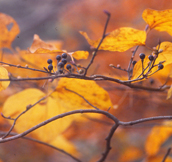
 Lindera obtusiloba Lauraceae
Lindera obtusiloba Lauraceae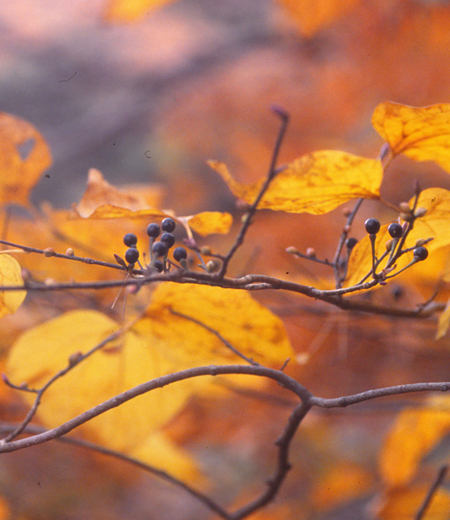 They are deciduous small trees or shrubs that grow wild in the pool of grove of mixed trees at the mountain areas. Cortex is tinged with gray and has lots of round lenticel, and the trunk grows to be about 18 cm wide. Young trees have yellowish green soft dense trichome, but later this trichome disappears and instead, turns into cadet brownish yellow. The leaves are wide egged-shaped about 5 to 15 cm long. It is usual that the top is split into 3 like shallow mound, but that some are not. The leaves turn into vivid yellow in autumn. The blossom, seasons are about March to April, and a dioecious plant (Shiyuuisyu). Yellow flowers with good smell bloom on the tree that extended the previous year before the leaves are open. They are known as one of the flowers that blossom, early spring at Mt. Takao, and have another name according to the flower color; ‘Benzoin obtusilobum’, The seeds are a spherical shape about 8 mm in diameters, and at first they are red, but later get matured to black in September to October.
They are deciduous small trees or shrubs that grow wild in the pool of grove of mixed trees at the mountain areas. Cortex is tinged with gray and has lots of round lenticel, and the trunk grows to be about 18 cm wide. Young trees have yellowish green soft dense trichome, but later this trichome disappears and instead, turns into cadet brownish yellow. The leaves are wide egged-shaped about 5 to 15 cm long. It is usual that the top is split into 3 like shallow mound, but that some are not. The leaves turn into vivid yellow in autumn. The blossom, seasons are about March to April, and a dioecious plant (Shiyuuisyu). Yellow flowers with good smell bloom on the tree that extended the previous year before the leaves are open. They are known as one of the flowers that blossom, early spring at Mt. Takao, and have another name according to the flower color; ‘Benzoin obtusilobum’, The seeds are a spherical shape about 8 mm in diameters, and at first they are red, but later get matured to black in September to October.
●Height about 2 to 6 m
●Place Trail 5,Ura-Takao, Oku-Takao, Minami-Takao -
Hydrangea scandens Saxifragaceae
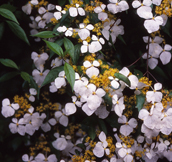
 Hydrangea scandens Saxifragaceae
Hydrangea scandens Saxifragaceae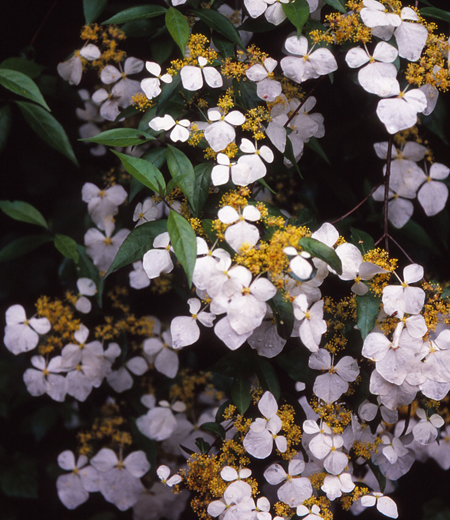 Deciduous shrubs found on slopes and at forest edges on streamside. Grow by extending many branches. Barks are dark gray and smooth. Young branches are brown with hair but turns grayish-white on the following year. Flowers resemble hydrangea and trees resemble deutzia crenata, hence the Japanese name Gaku-utsugi literally meaning hydrangea deutzia crenata. Leaves are 4 to 7 cm long, elongated oval-shaped and opposite. Tips are pointed, texture is shiny and have toothed margins (edges of leaves are like a teeth of saw). Another name is kon-teri-gi literally meang dark blue shine tree was named because the plant looks dark blue and reflects metallic shine. The blooming season is from May to June. Bloom light yellow-green flowers on 7 to 10 cm long inflorescence grow from branches. 2.5 to 3 cm long and white (surround inflorescence have no stamen or pistills) surround this flower.
Deciduous shrubs found on slopes and at forest edges on streamside. Grow by extending many branches. Barks are dark gray and smooth. Young branches are brown with hair but turns grayish-white on the following year. Flowers resemble hydrangea and trees resemble deutzia crenata, hence the Japanese name Gaku-utsugi literally meaning hydrangea deutzia crenata. Leaves are 4 to 7 cm long, elongated oval-shaped and opposite. Tips are pointed, texture is shiny and have toothed margins (edges of leaves are like a teeth of saw). Another name is kon-teri-gi literally meang dark blue shine tree was named because the plant looks dark blue and reflects metallic shine. The blooming season is from May to June. Bloom light yellow-green flowers on 7 to 10 cm long inflorescence grow from branches. 2.5 to 3 cm long and white (surround inflorescence have no stamen or pistills) surround this flower.
●Height about 1 to 1.5 m
●Place Trail 4, Trail 6 -
Deutzia scabra Saxifragaceae
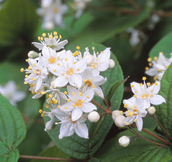
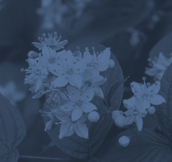 Deutzia scabra Saxifragaceae
Deutzia scabra Saxifragaceae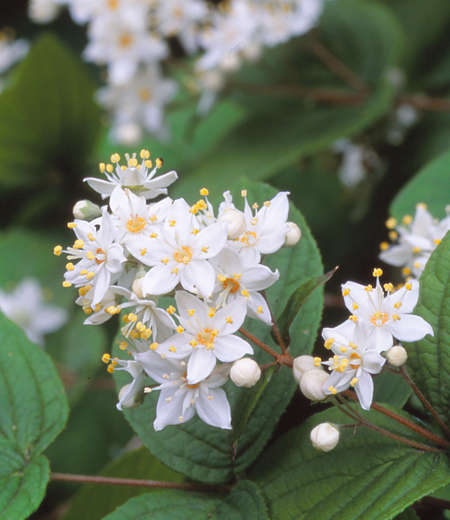 Deciduous shrubs found in sunny and dry slopes in mountains. Barks are grayish-brown and peel like strips of papers and have hollow inside the branch. Young branches are purplish brown with hair. Leaves are 4 to 7 cm long, egg-shaped and lower parts of leaves covering stems. Have hair on both sides with toothed margins (edges of leaves are like a teeth of saw). The Japanese name Maruba-utsugi was named because this plants have round-shaped leaves in Deutzia crenata (Utsugi). In autumn, leaves turn to purplish-brown. The blooming season is May. Bloom white flowers facing upward on cylindrical inflorescence (flower stems) grow from petioles. Flowers are 1.5 cm in diameter, star-shaped and five petals are with yellow flower disks (support petals). After flowering, bear hairy spherical fruits, 3 mm in diameter.
Deciduous shrubs found in sunny and dry slopes in mountains. Barks are grayish-brown and peel like strips of papers and have hollow inside the branch. Young branches are purplish brown with hair. Leaves are 4 to 7 cm long, egg-shaped and lower parts of leaves covering stems. Have hair on both sides with toothed margins (edges of leaves are like a teeth of saw). The Japanese name Maruba-utsugi was named because this plants have round-shaped leaves in Deutzia crenata (Utsugi). In autumn, leaves turn to purplish-brown. The blooming season is May. Bloom white flowers facing upward on cylindrical inflorescence (flower stems) grow from petioles. Flowers are 1.5 cm in diameter, star-shaped and five petals are with yellow flower disks (support petals). After flowering, bear hairy spherical fruits, 3 mm in diameter.
●Height about 1 to 1.5 m
●Place Trail 5 and 6 -
Hydrangea hirta Saxifragaceae
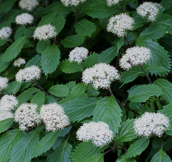
 Hydrangea hirta Saxifragaceae
Hydrangea hirta Saxifragaceae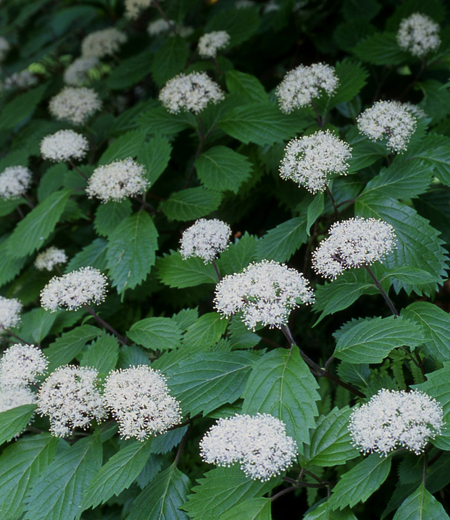 Deciduous shrubs found in forests from hills to mountains. Grow by extending branches. The Japanese name Ko-ajisail literally meaning small hydrangea was named because this plant is a smaller sized hydrangea. Leaves are 5 to 8 cm long, egg-shaped with pointed tip and alternate. Have hair on both sides and half of margins towards tips are toothed margins (edges of leaves are like a teeth of saw). Turn yellow in autumn. The blooming season is on June. Bloom light blue flowers on 5 cm in diameter inflorescence grow from petioles. Each flower is 5 mm in diameter and five petals with 10 stamens protrudes. Have no ornamental flowers which most of hydrangeas have. Fruits are 3 mm long, egg-shaped and bracts and pistils remain.
Deciduous shrubs found in forests from hills to mountains. Grow by extending branches. The Japanese name Ko-ajisail literally meaning small hydrangea was named because this plant is a smaller sized hydrangea. Leaves are 5 to 8 cm long, egg-shaped with pointed tip and alternate. Have hair on both sides and half of margins towards tips are toothed margins (edges of leaves are like a teeth of saw). Turn yellow in autumn. The blooming season is on June. Bloom light blue flowers on 5 cm in diameter inflorescence grow from petioles. Each flower is 5 mm in diameter and five petals with 10 stamens protrudes. Have no ornamental flowers which most of hydrangeas have. Fruits are 3 mm long, egg-shaped and bracts and pistils remain.
●Height about 1 to 1.5 m
●Place Oku-Takao -
Hydrangea involucrata Saxifragaceae
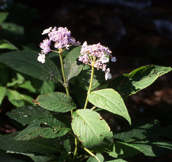
 Hydrangea involucrata Saxifragaceae
Hydrangea involucrata Saxifragaceae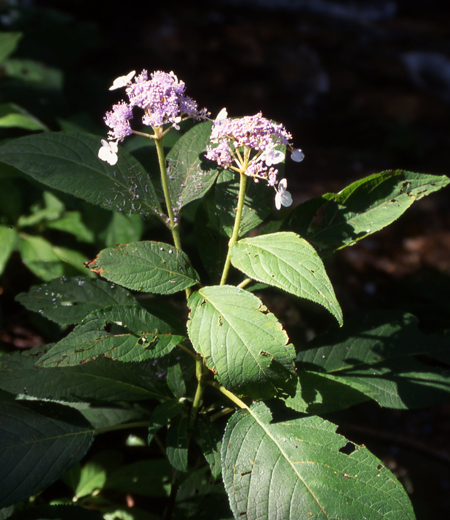 Deciduous shrubs found in wet streamside and forest edges in mountains. Grow by extending branches. Young branches have hairs densely placed. Leaves are 10 to 20 cm long, oval-shaped and opposite. Have pointed tip with toothed margins (edges of leaves are like a teeth of saw). Also have rough hairs on both sides and rough at a touch. The Japanese name Tama-ajisai literally meaning spherical hydrangea was named because spherical buds are striking. The blooming season is from April to September and start blooming after rainy season is over. Inflorescence (flower stems) are 3 cm in diameter spherical-shaped covered with flower disks. And then, this flower disks fell apart and bloom light bue small flowers and three to five white ornamental (surround inflorescence have no stamen or pistills). Fruits are 3.5 mm long egg-shaped with pistil remain at tips.
Deciduous shrubs found in wet streamside and forest edges in mountains. Grow by extending branches. Young branches have hairs densely placed. Leaves are 10 to 20 cm long, oval-shaped and opposite. Have pointed tip with toothed margins (edges of leaves are like a teeth of saw). Also have rough hairs on both sides and rough at a touch. The Japanese name Tama-ajisai literally meaning spherical hydrangea was named because spherical buds are striking. The blooming season is from April to September and start blooming after rainy season is over. Inflorescence (flower stems) are 3 cm in diameter spherical-shaped covered with flower disks. And then, this flower disks fell apart and bloom light bue small flowers and three to five white ornamental (surround inflorescence have no stamen or pistills). Fruits are 3.5 mm long egg-shaped with pistil remain at tips.
●Height about 1 to 2 m
●Place Trail 1 and 2,Trail 4 to 6,Ura-Takao, Oku-Takao, Minami-Takao -
Prunus jamasakura Rosaceae
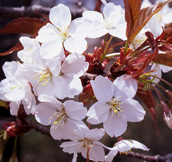
 Prunus jamasakura Rosaceae
Prunus jamasakura Rosaceae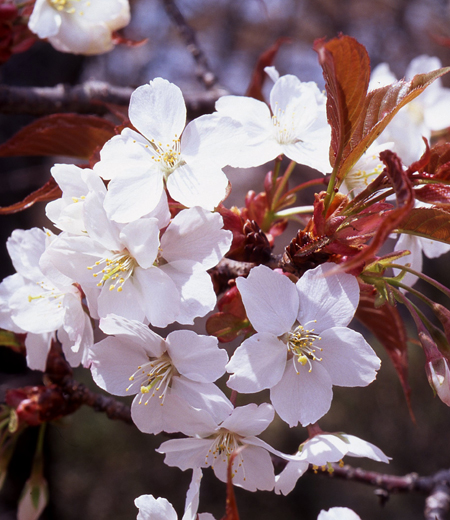 They are an evergreen tree that grows wild at sunny low mountains. They are the most well-known one among wild cherry blossoms, and they blossom a little bit later than Prunus yedoensis, when at the same time young leaves are to be open in April. Cortex is dark bistered in color and horizontally-long lenticels show up. The trunk grows to be about 60 cm wide. This tree is planted as garden trees and trees lining the streets as well as is utilized for house furnishings and materials of musical instrument because wood building materials are compact with good smell. The leaves are long elliptically-shaped about 8 to 12 cm long, 3 to 5 cm wide with the finely sharp top as well as a sawtooth (Kyoshi: tooth-like rough part like a saw at the root of a leaf) at the edge. In autumn the leaves turn into yellow or orange color. 2 to 5 of the flowers sprout beside the leaves on the branches that extended the previous year, about 2.5 to 3.5 cm in diameter, consisting of 5 flower petals, tinged with white or pale showy pink. The seeds are a spherical shape, about 8 mm in diameter, and get matured to black-purple in May to June.
They are an evergreen tree that grows wild at sunny low mountains. They are the most well-known one among wild cherry blossoms, and they blossom a little bit later than Prunus yedoensis, when at the same time young leaves are to be open in April. Cortex is dark bistered in color and horizontally-long lenticels show up. The trunk grows to be about 60 cm wide. This tree is planted as garden trees and trees lining the streets as well as is utilized for house furnishings and materials of musical instrument because wood building materials are compact with good smell. The leaves are long elliptically-shaped about 8 to 12 cm long, 3 to 5 cm wide with the finely sharp top as well as a sawtooth (Kyoshi: tooth-like rough part like a saw at the root of a leaf) at the edge. In autumn the leaves turn into yellow or orange color. 2 to 5 of the flowers sprout beside the leaves on the branches that extended the previous year, about 2.5 to 3.5 cm in diameter, consisting of 5 flower petals, tinged with white or pale showy pink. The seeds are a spherical shape, about 8 mm in diameter, and get matured to black-purple in May to June.
●Height about 15 to 25 m
●Place Trail 1, Trail 5, Mt.Inari, Minami-Takao, Oku-Takao -
Kerria japonica Rosaceae
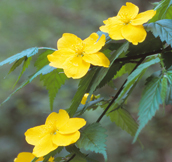
 Kerria japonica Rosaceae
Kerria japonica Rosaceae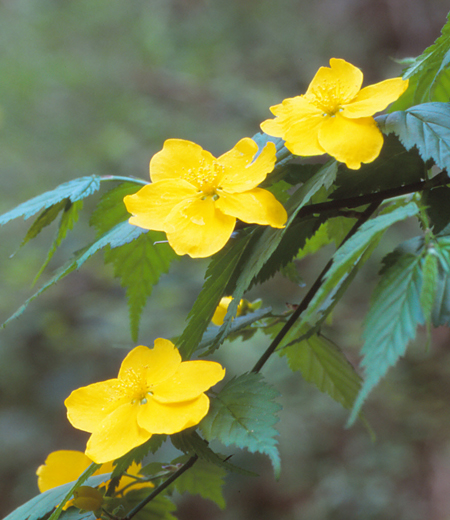 They are a deciduous shrub that grows wild at humid places along the mountain streams in the mountain areas. They develop like the clump style (Kabudachi: the branched leaves are harvested) with the branches hang over others sideways. Cortexes of young leaves of young trees are bright green and smooth feeling to touch, while the ones of adult trees change to bistered-color wood. The trunk withers in 3 to 4 years to replace with a next new one. The leaves are long elliptically-shaped, about 4 to 8 cm long, 2 to 4 cm wide with the finely long sharp top as well as a scraggly sawtooth (Kyoshi: tooth-like rough part like a saw at the root of a leaf) at the edge. The characteristics of the leaves are thin, and with the leaf veins bulging at the back surface bearing short trichome on them. The blossom season are about April to May and 1 vivid yellow flower blossom on each of a new branch. The flower consists of 5 flower petals, about 3 to 5 cm in diameter. The seeds are long elliptically-shaped about 4 mm long, and 1 to 5 of them grow together in clusters, which are at first tinged with green and get matured to brownish-red in September.
They are a deciduous shrub that grows wild at humid places along the mountain streams in the mountain areas. They develop like the clump style (Kabudachi: the branched leaves are harvested) with the branches hang over others sideways. Cortexes of young leaves of young trees are bright green and smooth feeling to touch, while the ones of adult trees change to bistered-color wood. The trunk withers in 3 to 4 years to replace with a next new one. The leaves are long elliptically-shaped, about 4 to 8 cm long, 2 to 4 cm wide with the finely long sharp top as well as a scraggly sawtooth (Kyoshi: tooth-like rough part like a saw at the root of a leaf) at the edge. The characteristics of the leaves are thin, and with the leaf veins bulging at the back surface bearing short trichome on them. The blossom season are about April to May and 1 vivid yellow flower blossom on each of a new branch. The flower consists of 5 flower petals, about 3 to 5 cm in diameter. The seeds are long elliptically-shaped about 4 mm long, and 1 to 5 of them grow together in clusters, which are at first tinged with green and get matured to brownish-red in September.
●Height about 1 to 2 m
●Place Ura-Takao, Oku-Takao -
Prunus grayana Rosaceae
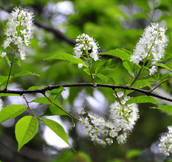
 Prunus grayana Rosaceae
Prunus grayana Rosaceae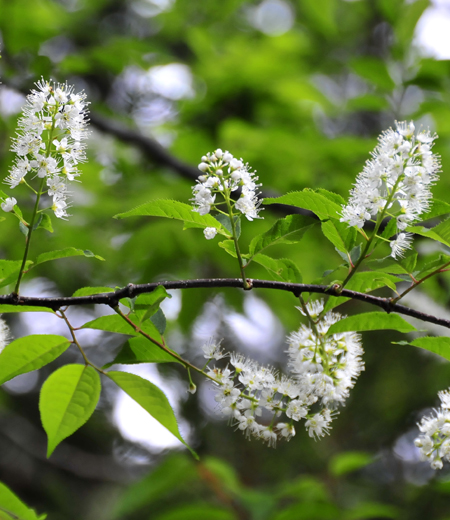 They are an evergreen tree that grows wild at sunny mountainside along the mountain stream. The trunk grows to be about 60 cm wide. Cortex is tinged with dark purplish bistered with horizontally-long clear lenticels. The branches are black-purple and shiny. The leaves are elliptically-shaped, about 8 to 11 cm long, with the long sharp top as well as a bristle-pointed sawtooth (Kyoshi: tooth-like rough part like a saw at the root of a leaf) at the edge. The blossom seasons are about April to May. They bear a brush-like spike which sprouts lots of new small white flowers at the top of a new branch. One flower is about 6 mm in diameter with 5 flower petals and male stamens outshoot long. The seeds are egged-shaped about 8 mm in diameter, and are tinged with red and then get matured to black in August to September, also to be edible. People in Niigata Prefecture use the salted buds of the flowers and the salted young seeds as edible food called ‘An-ningo’.
They are an evergreen tree that grows wild at sunny mountainside along the mountain stream. The trunk grows to be about 60 cm wide. Cortex is tinged with dark purplish bistered with horizontally-long clear lenticels. The branches are black-purple and shiny. The leaves are elliptically-shaped, about 8 to 11 cm long, with the long sharp top as well as a bristle-pointed sawtooth (Kyoshi: tooth-like rough part like a saw at the root of a leaf) at the edge. The blossom seasons are about April to May. They bear a brush-like spike which sprouts lots of new small white flowers at the top of a new branch. One flower is about 6 mm in diameter with 5 flower petals and male stamens outshoot long. The seeds are egged-shaped about 8 mm in diameter, and are tinged with red and then get matured to black in August to September, also to be edible. People in Niigata Prefecture use the salted buds of the flowers and the salted young seeds as edible food called ‘An-ningo’.
●Height about 10 to 15 m
●Place Mt.Inari, Oku-Takao, Minami-Takao -
Rubus hirsutus(Raspberry) Rosaceae
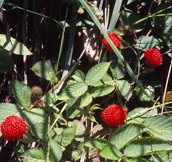
 Rubus hirsutus(Raspberry) Rosaceae
Rubus hirsutus(Raspberry) Rosaceae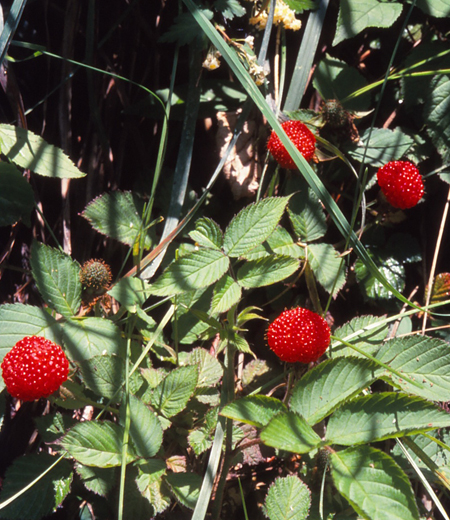 Deciduous shrubs found at roadside and forest edges in mountains. The Japanese name is Kusa-ichigo (kusa means plants, ichigo means strawberry). Have the word plants and the entire plants are not tall but this is in a rubus genes. Have soft hair densely on stems, branches and leaves. Glandular hair (hair-like protrusions to release secretion) and spikes are irregularly placed. Three to five leaves are as one set and alternate. Leaflets (leaf-like parts of compound leaves) are 3 to 7 cm long and oval-shaped with toothed margins (edges of leaves are like a teeth of saw). Leaves turn to red in autumn. The blooming season is from April to May, 4 cm in diameter, one to two white flowers bloom on the tip of short branches. Five petals are facing upwards and have short hair on calyx. Fruits are tiny spherical-shaped and about 1 cm in diameter collective fruits. Turn red from late May to June. Have sweet taste and nice perfume.
Deciduous shrubs found at roadside and forest edges in mountains. The Japanese name is Kusa-ichigo (kusa means plants, ichigo means strawberry). Have the word plants and the entire plants are not tall but this is in a rubus genes. Have soft hair densely on stems, branches and leaves. Glandular hair (hair-like protrusions to release secretion) and spikes are irregularly placed. Three to five leaves are as one set and alternate. Leaflets (leaf-like parts of compound leaves) are 3 to 7 cm long and oval-shaped with toothed margins (edges of leaves are like a teeth of saw). Leaves turn to red in autumn. The blooming season is from April to May, 4 cm in diameter, one to two white flowers bloom on the tip of short branches. Five petals are facing upwards and have short hair on calyx. Fruits are tiny spherical-shaped and about 1 cm in diameter collective fruits. Turn red from late May to June. Have sweet taste and nice perfume.
●Height about 20 to 50 cm
●Place Trail 2, Trail 4, Jyataki, Oku-Takao -
Chaenomeles japonica Rosaceae
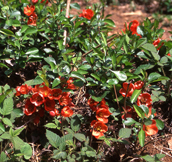
 Chaenomeles japonica Rosaceae
Chaenomeles japonica Rosaceae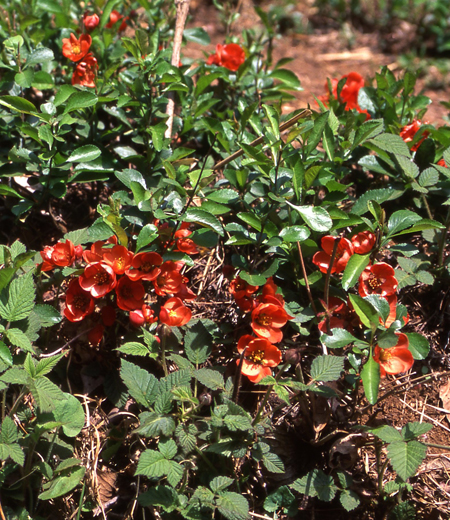 Deciduous shrubs found in sunny riverbanks in mountains. Lower parts of trunk grow horizontally and have many spines on branches. Leaves are 2 to 5 cm long obovate and alternate. Have round tip with toothed margins (edges of leaves are like a teeth of saw). The blooming season is from April to May and male flowers and female flowers exist on one tree. Two to four flowers with male flowers and bisexual flowers (stamen and pistil coexist in one flower) bloom on the tip of branches before leaves open. Flowers are about 2.5 cm in diameter and have five petals. Fruits are about 3 cm in diameter and not complete round-shaped. Turn yellow as they ripen. It looks like pears at first and have nice perfumes but it is too hard and bitter and not suitable for eating in raw. Are also called as Shidomi and salted or fruit liquor.
Deciduous shrubs found in sunny riverbanks in mountains. Lower parts of trunk grow horizontally and have many spines on branches. Leaves are 2 to 5 cm long obovate and alternate. Have round tip with toothed margins (edges of leaves are like a teeth of saw). The blooming season is from April to May and male flowers and female flowers exist on one tree. Two to four flowers with male flowers and bisexual flowers (stamen and pistil coexist in one flower) bloom on the tip of branches before leaves open. Flowers are about 2.5 cm in diameter and have five petals. Fruits are about 3 cm in diameter and not complete round-shaped. Turn yellow as they ripen. It looks like pears at first and have nice perfumes but it is too hard and bitter and not suitable for eating in raw. Are also called as Shidomi and salted or fruit liquor.
●Height about 30 cm to 1 m
●Place Ura-Takao -
Stephanandra incisa Rosaceae
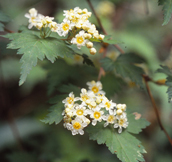
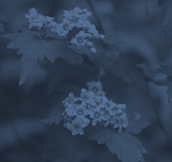 Stephanandra incisa Rosaceae
Stephanandra incisa Rosaceae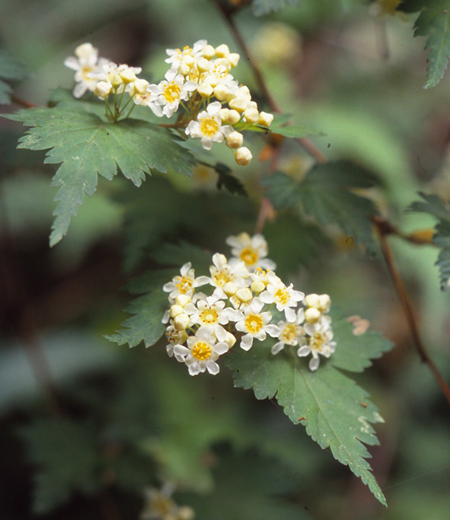 They are a deciduous shrub that grows wild in the pool in the forests and on the roadside around the hilly areas to the mountain district. They are frequently branched out and young branch is tinged with red-brown and bears trichome. Their appearance of small white flower alike Deutzia crenata (Saxifragaceae) is compared as fractured rice, Kogome, which is why they are named. The leaves are egged-shaped about 2 to 6 cm long, about 1.5 to 3.5 cm wide, have short leafstalks, and grow alternative on the branches. The leaves have a sharp thin top, bear soft trichome, and are roughly split at the edge. The blossom season is about May, when short inflorescence (Kajo: stalk blooming flowers) sprouts from the limb of the branch or beside the leaf that extended that year to bear many flowers about 4 mm in diameter. The flower consists of 5 s patulate-shaped flower petals; below here 5 of white egged-shaped sepals are open to look like a small flower petal with inside in yellow. When the flowers wither, they bear a spherical shape covered with calyx about 2 to 3 mm in diameter.
They are a deciduous shrub that grows wild in the pool in the forests and on the roadside around the hilly areas to the mountain district. They are frequently branched out and young branch is tinged with red-brown and bears trichome. Their appearance of small white flower alike Deutzia crenata (Saxifragaceae) is compared as fractured rice, Kogome, which is why they are named. The leaves are egged-shaped about 2 to 6 cm long, about 1.5 to 3.5 cm wide, have short leafstalks, and grow alternative on the branches. The leaves have a sharp thin top, bear soft trichome, and are roughly split at the edge. The blossom season is about May, when short inflorescence (Kajo: stalk blooming flowers) sprouts from the limb of the branch or beside the leaf that extended that year to bear many flowers about 4 mm in diameter. The flower consists of 5 s patulate-shaped flower petals; below here 5 of white egged-shaped sepals are open to look like a small flower petal with inside in yellow. When the flowers wither, they bear a spherical shape covered with calyx about 2 to 3 mm in diameter.
●Height about1 to 2 m
●Place Trail 5, Mt.Inari, Oku-Takao -
Rubus parvifolius Rosaceae
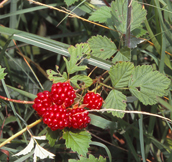
 Rubus parvifolius Rosaceae
Rubus parvifolius Rosaceae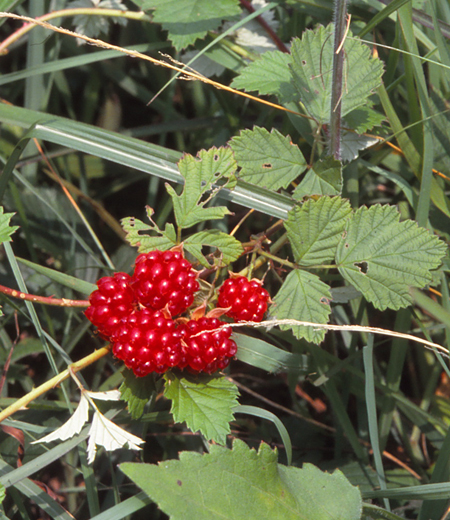 Deciduous shrubs found in sunny roadside and riverbanks in mountains. Stems grow on the ground like vines and rooting at intervals. The Japanese name Nawashiro-ichigo literally meaning rice sprout strawberry was named because fruits are ripen around June when rice sprout. Three to five leaves are in one set and alternate. Leaflets (leaf-like parts of compound leaves) is 2 to 4 cm in diameter, round-like diamond shaped with round tip and toothed margins (edges of leaves are like a teeth of saw). Have white hair densely placed on the back. The blooming season is from May to June. Bloom 1 to 2 cm in diameter, red-purple flowers upward in florescence. Have five petals and does not open which covered stamen. Fruits are 1.5 cm in diameter collective fruits and turn red as they ripen. Is edible in raw, fruit liquor or jam.
Deciduous shrubs found in sunny roadside and riverbanks in mountains. Stems grow on the ground like vines and rooting at intervals. The Japanese name Nawashiro-ichigo literally meaning rice sprout strawberry was named because fruits are ripen around June when rice sprout. Three to five leaves are in one set and alternate. Leaflets (leaf-like parts of compound leaves) is 2 to 4 cm in diameter, round-like diamond shaped with round tip and toothed margins (edges of leaves are like a teeth of saw). Have white hair densely placed on the back. The blooming season is from May to June. Bloom 1 to 2 cm in diameter, red-purple flowers upward in florescence. Have five petals and does not open which covered stamen. Fruits are 1.5 cm in diameter collective fruits and turn red as they ripen. Is edible in raw, fruit liquor or jam.
●Height about 20 to 30 cm
●Place Ura-Takao
